INDONESIA
(Updated 2017)
PREAMBLE
This report provides information on the status and development of nuclear power programmes in Indonesia, including factors related to the effective planning, decision making and implementation of the nuclear power programme that together lead to safe and economical operation of nuclear power plants.
The CNPP summarizes organizational and industrial aspects of nuclear power programmes and provides information about the relevant legislative, regulatory and international framework in Indonesia.
Indonesia is planning a nuclear power programme by developing a roadmap for the implementation of nuclear power plants with the involvement of national stakeholders.
1. GENERAL ENERGY OVERVIEW
1.1. Energy Information
1.1.1. Energy Policy
In October 2014, the Government of Indonesia enacted Government Regulation No. 79 of 2014 in regard to the National Energy Policy (NEP). NEP is a comprehensive policy which covers both the supply and the demand sides. It serves as the main guideline in national energy management to achieve the security of domestic energy supply.
NEP 2014 would reduce gasoline dependency and increase the use of renewable energy. Figure 1 shows that NEP sets a clear target of the share of each type of primary energy from the year 2025 up to the year 2050, as follows:
The share of new and renewable energy is at least 23% in 2025 and at least 31% in 2050 as long as their economics comply.
The share of oil is less than 25% in 2025 and less than 20% in 2050.
The share of coal is minimum 30% in 2025 and minimum 25% in 2050.
The share of gas is minimum 22% in 2025 and minimum 24% in 2050.
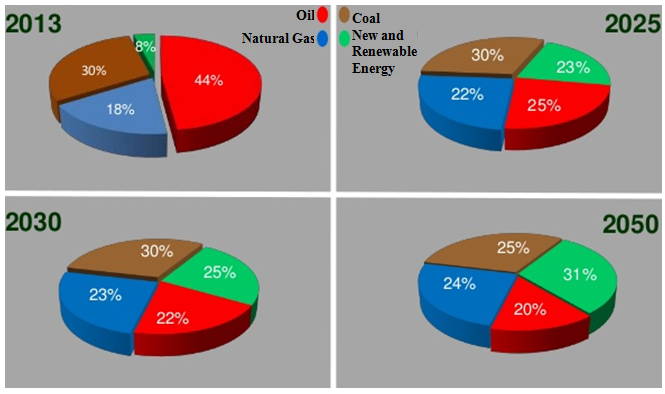
FIG. 1. Energy mix target.
In NEP 2014, nuclear is included in the new energy group, i.e. energy that comes from new technology.
Because utilization of nuclear energy requires high safety and security standards and also considering the impact of nuclear radiation hazards on the environment, nuclear energy utilization is regarded as the last option. However, in-depth studies which have been conducted regarding the technological development of nuclear energy for peaceful purposes, fulfilling the needs of the growing energy demand by supplying national energy on a large scale, reducing carbon emissions and the urgent national interest suggest that nuclear energy can be utilized.
1.1.2. Estimated Available Energy
TABLE 1. ESTIMATED AVAILABLE ENERGY SOURCES
Specific unit |
Estimated available energy sources | ||||||||
| Fossil fuels | Nuclear | Renewables | |||||||
| Solid1 | Liquid1 | Gas1 | Uranium3 | Thorium3 | Hydro2 | Geothermal1 | Solar2 | Biomass1 | |
| Million tons | Billion barrel | TSCF | Metric tons | Metric tons | GW | GW | GW | GW | |
| Total amount in specific unit | 158 873.02 | 7.31 | 151.33 | 74 398 | 130 974 | 94.48 | 29.54 | 207.9 | 56.09 |
| Total amount in exajoule (EJ) | 4 656.18 | 44.72 | 159.66 | 2 180.43 | 3 838.53 | 2.98 | 0.93 | 6.56 | 1.77 |
Sources: 1Handbook of Energy and Economic Statistics of Indonesia2016, Ministry of Energy and Mineral Resources;
2 Statistik EBTKE 2016, Ministry of Energy and Mineral Resources;
3 National Nuclear Energy Agency (Batan).
1.1.3. Energy Statistics
TABLE 2. ENERGY STATISTICS
| Year | 2005 | 2006 | 2007 | 2008 | 2009 | 2010 | 2011 | 2012 | 2013 | 2014 | 2015 | ||
| Final energy consumption | |||||||||||||
| * Total | 4.68 | 4.75 | 4.93 | 4.85 | 5.25 | 5.72 | 5.97 | 6.36 | 6.42 | 6.69 | 5.40 | ||
| - Solid | 0.38 | 0.52 | 0.71 | 0.55 | 0.48 | 0.80 | 0.84 | 0.91 | 1.04 | 1.26 | 0.40 | ||
| - Liquids | 2.21 | 2.12 | 2.14 | 2.07 | 2.43 | 2.64 | 2.76 | 3.06 | 2.97 | 2.65 | 2.22 | ||
| - Gases | 0.50 | 0.48 | 0.47 | 0.60 | 0.69 | 0.67 | 0.71 | 0.733 | 0.736 | 1.01 | 1.02 | ||
| - Nuclear | 0.00 | 0.00 | 0.00 | 0.00 | 0.00 | 0.00 | 0.00 | 0.00 | 0.00 | 0.00 | 0.00 | ||
| - Hydro | 0.00 | 0.00 | 0.00 | 0.00 | 0.00 | 0.00 | 0.00 | 0.00 | 0.00 | 0.00 | 0.00 | ||
| Other renewables | |||||||||||||
| - Geothermal | 0.00 | 0.00 | 0.00 | 0.00 | 0.00 | 0.00 | 0.00 | 0.00 | 0.00 | 0.00 | 0.00 | ||
| - Biomass | 1.58 | 1.62 | 1.61 | 1.63 | 1.64 | 1.60 | 1.66 | 1.64 | 1.67 | 1.77 | 1.77 | ||
| Energy production | |||||||||||||
| * Total | 11.40 | 12.54 | 13.05 | 13.93 | 14.59 | 15.52 | 17.64 | 18.62 | 20.16 | 17.98 | 17.63 | ||
| - Solid | 4.47 | 5.68 | 6.35 | 7.04 | 7.50 | 8.06 | 10.35 | 11.31 | 13.16 | 10.99 | 11.07 | ||
| - Liquids | 1.98 | 1.97 | 1.95 | 2.03 | 2.02 | 1.88 | 2.00 | 2.06 | 1.89 | 2.15 | 1.75 | ||
| - Gases | 3.15 | 3.11 | 2.96 | 3.04 | 3.23 | 3.59 | 3.43 | 3.35 | 3.13 | 2.76 | 2.74 | ||
| - Nuclear | 0.00 | 0.00 | 0.00 | 0.00 | 0.00 | 0.00 | 0.00 | 0.00 | 0.00 | 0.00 | 0.00 | ||
| - Hydro | 0.2 | 0.14 | 0.16 | 0.17 | 0.16 | 0.25 | 0.18 | 0.18 | 0.24 | 0.22 | 0.20 | ||
| -Other renewables | |||||||||||||
| Geothermal | 0.05 | 0.05 | 0.05 | 0.06 | 0.07 | 0.07 | 0.07 | 0.07 | 0.07 | 0.09 | 0.09 | ||
| Biomass | 1.54 | 1.58 | 1.57 | 1.59 | 1.6 | 1.65 | 1.6 | 1.64 | 1.67 | 1.77 | 1.77 | ||
| Net import (Import - Export) | |||||||||||||
| * Total | -3.34 | -4.38 | -4.8 | -4.66 | -5.59 | -5.9 | -7.35 | -7.87 | -8.22 | -9.10 | -8.77 | ||
Source: Handbook of Energy and Economic Statistics of Indonesia 2016, Ministry of Energy and Mineral Resources.
1.2. The Electricity System
1.2.1. Electricity Policy and Decision Making Process
The Indonesian power sector is governed and regulated by the following law and government regulations:
Law No. 15/1985 regarding electricity;
Government Regulation No. 3/2005 regarding amendment of Government Regulation No. 10/1985 regarding electricity;
Ministerial Decree of the Minister of Energy and Mineral Resources (MEMR) No. 9/2005;
Ministerial Decree of MEMR No.10/2005.
The Directorate General of Electricity (DGE) under the Ministry of Energy and Mineral Resources is primarily responsible for formulating electricity policies and regulations. One responsibility of DGE is to prepare general national electricity planning to meet electricity power demand in a reliable and sustainable way. The National Electricity General Planning (RUKN, Rencana Umum Kelistrikan Nasional) is an integrated policy in the electricity sector comprising projection of electricity demand and supply of power generation, investment and financing, utilization of primary energy resources, as well as new and renewable energy for power generation.
According to Act No. 15 on Electricity (1985) and Government Regulation No. 26 on supply and utilization of power generation (2006), the electricity utility should undertake planning and have an Electricity Power Supply Business Plan (RUPTL, Rencana Umum Pengusahaan Tenaga Listrik).
1.2.2. Structure of Electric Power Sector
The structure of the current Indonesian electricity supply industry is shown in Fig. 2. According to Law No. 15/1985, Perusahaan Listrik Negara (PLN), which is a state owned enterprise as well as a limited liability company, is the only authority in the country that provides electricity to all Indonesian people. In serving the national electricity demand, PLN produces electricity from its own power plants, including generator companies which are PLN’s subsidiaries. PLN also acts as the single buyer that purchases electricity from independent power producers (IPP). Other power producers apart from PLN and IPP are “captive powers”, mostly industries that produce power for their own use, and some other smaller companies including cooperatives that sell their electricity directly to consumers.
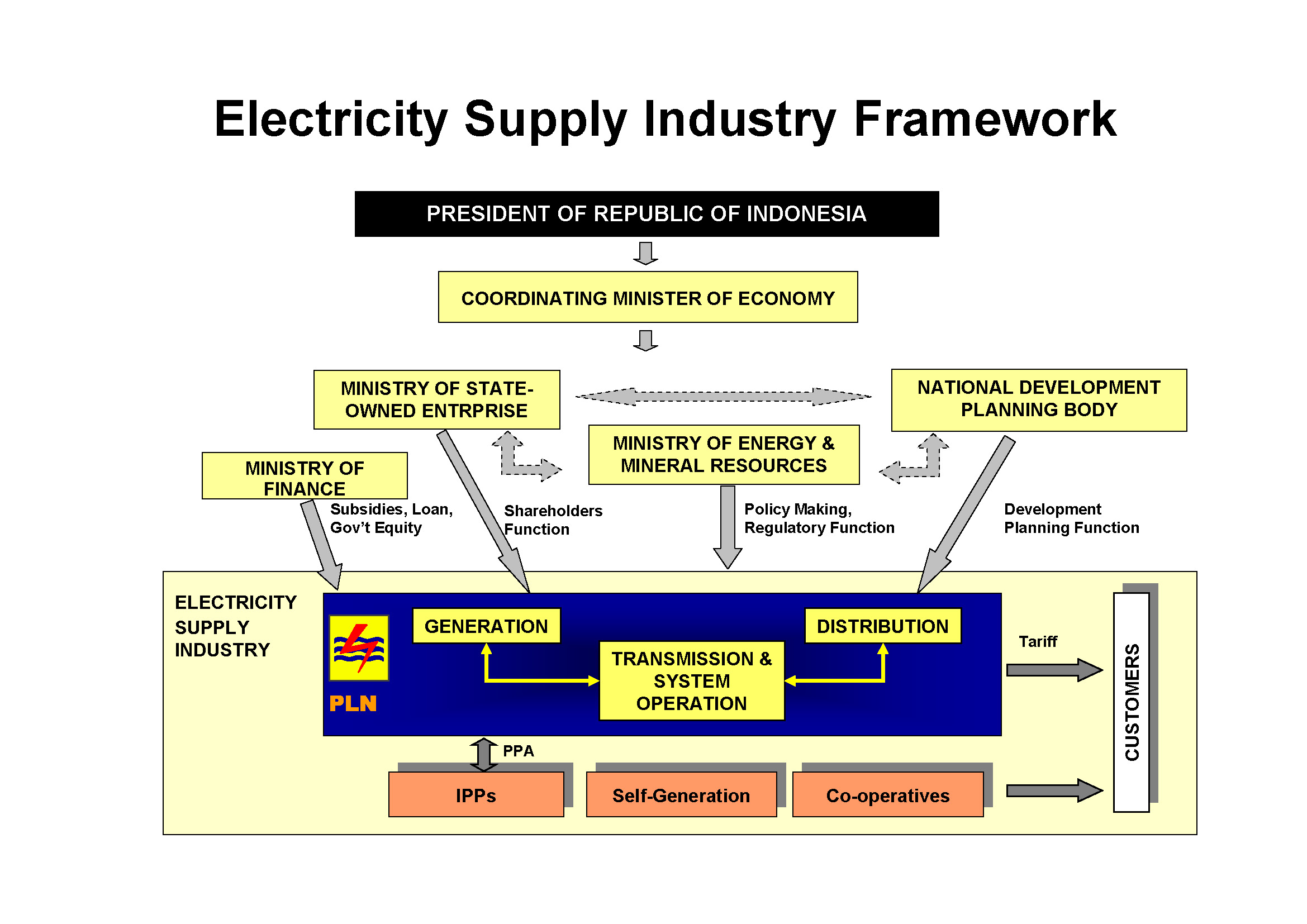
FIG. 2. The structure of current electricity supply industry.
PLN builds and owns most electricity infrastructure in the country. In terms of generation facilities, PLN owns almost every type of power plant, such as coal fired and oil fired steam power plants, and gas turbine, geothermal, hydroelectric and diesel plants. Most of these generation facilities are under the management of PLN’s subsidiaries, PT Indonesia Power and PT Pembangkitan Jawa Bali (PT PJB).
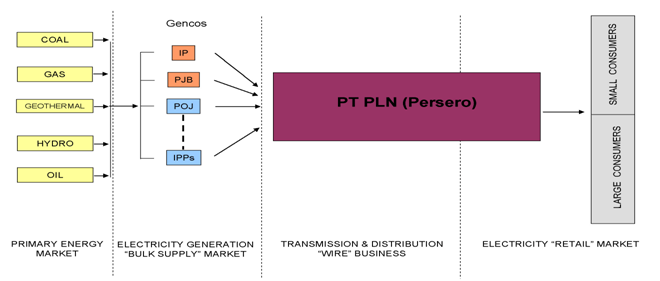
FIG. 3. Current electricity market.
In delivering electricity to its large, medium and small customers while maintaining the quality and reliability of its services, PT PLN developed extensive transmission and distribution networks, including the large scale interconnection power grid in the Java–Bali system.
Furthermore, PT PLN established 10 subsidiaries and 2 joint ventures, some of which include:
PT Indonesia Power, whose main business is electricity generation.
PT Pembangkitan Jawa Bali (PT PJB), whose main business is electricity generation.
PT National Electricity Service of Batam Island (PT Pelayanan Listrik Nasional Batam — PLN Batam), that engages in the business of electricity provision for public purposes in the Region Batam Island.
PT Indonesia Comnets Plus, whose main business is telecommunication.
PT Prima Layanan Nasional Enjiniring (PT PLN Enjiniring), a company in engineering, consultant and construction supervision.
PT National Electricity Service Tarakan (PT PLN Tarakan), a provider of electricity for public purposes in Tarakan Island of East Kalimantan.
PT Geo Dipa Energi, a joint venture between PT PLN and PT PERTAMINA, whose business is in electricity generation, especially geothermal power plant.
PT PLN Batubara, a coal mine and coal supplier for coal power plants.
PT PLN Geothermal, a generating company with geothermal energy.
Majapahit Holding BV, a holding company in Amsterdam, Holland.
PT Haleyora Power, a company that operates and maintains the transmission and distribution system. It established a Joint Venture Company (JVC) in the field of energy provision called PT Energi Pelabuhan Indonesia (EPI), with PT PELINDO II.
1.2.3. Main Indicators
Power systems in Indonesia are divided into two types: interconnected systems and isolated systems. The power systems which are well interconnected are the Java–Bali system and the Sumatra system, while the rest are still relatively isolated.
In the end of 2015 the total installed capacity and number of generating units of PLN (holding and subsidiary) was 40 265.26 MW and 5 218 units, with 27 867.88 MW (69.21%) capacity installed in the Java–Bali system. Total installed capacity increased by 2.57% over the previous year.
TABLE 3. ELECTRICITY PRODUCTION, CONSUMPTION AND CAPACITY
| Average annual growth rate (%) | ||||||||
| 2005 | 2010 | 2011 | 2012 | 2013 | 2014 | 2015 | 2005 to 2015 | |
| Capacity of electrical plants (GWe) | ||||||||
| Hydro | 3.22 | 3.52 | 3.51 | 3.52 | 3.52 | 3.53 | 3.57 | 0.20% |
| Steam | 6.9 | 9.45 | 12.05 | 14.45 | 15.55 | 20.45 | 21.09 | 1.51% |
| Gas | 2.72 | 3.22 | 2.84 | 2.97 | 2.89 | 3.01 | 2.98 | 0.05% |
| Combine cycle | 6.28 | 6.95 | 7.83 | 8.81 | 8.81 | 8.89 | 8.89 | 0.38% |
| Geothermal | 0.39 | 0.44 | 0.44 | 0.55 | 0.57 | 0.57 | 0.55 | 0.08% |
| Diesel PP | 2.99 | 3.27 | 2.57 | 2.60 | 2.85 | 2.80 | 3.18 | 1.31% |
| Mini gas PP | 0.012 | 0.039 | 0.026 | 0 | 0 | 0 | 0 | 0.15% |
| Other renewable | ||||||||
| Wind | 0 | 0.0003 | 0.0003 | 0.0003 | 0.0004 | 0.0005 | 0.0010 | 14.27% |
| Solar | 0 | 0.0002 | 0.0012 | 0.0062 | 0.0079 | 0.0087 | 0.0089 | 9.75% |
| Total | 22.51 | 26.89 | 29.27 | 32.90 | 34.21 | 39.26 | 40.27 | 0.84% |
| Electricity production (TWh) | ||||||||
| Hydro | 9.83 | 15.83 | 10.32 | 10.52 | 13.01 | 11.16 | 10.00 | -0.66% |
| Steam | 42.27 | 54.41 | 62.34 | 73.82 | 80.93 | 89.25 | 95.82 | 1.53% |
| Gas | 6.04 | 7.86 | 8.25 | 5.67 | 5.92 | 5.45 | 3.44 | -3.60% |
| Combine cycle | 31.27 | 36.81 | 40.41 | 34.57 | 36.42 | 38.07 | 38.71 | 0.39% |
| Geothermal | 3.01 | 3.4 | 3.49 | 3.56 | 4.34 | 4.28 | 4.39 | 0.64% |
| Diesel PP | 5.76 | 5.1 | 4.01 | 3.48 | 3.21 | 3.55 | 3.03 | -1.89% |
| Mini gas PP | 0 | 0.073 | 0.048 | 0.055 | 0.38 | 1.09 | 1.23 | 7.82% |
| Other renewable | ||||||||
| Wind | 0 | 0.00002 | 0.0007 | 0.0028 | 0.0055 | 0 | 0 | 3.53% |
| Solar | 0 | 0.0005 | 0 | 0 | 0 | 0.0068 | 0.0053 | 0.28% |
| Rent of generator | 3.1 | 8.23 | 13.89 | 18.07 | 19.75 | 22.44 | 19.84 | 1.26% |
| Buy | 26.09 | 38.08 | 40.68 | 50.56 | 52.22 | 53.26 | 57.51 | 1.56% |
| Total | 127.37 | 169.77 | 183.42 | 200.32 | 216.19 | 228.55 | 233.98 | 0.84% |
| Total electricity consumption (TWh) | 104.86 | 142.90 | 154.18 | 167.41 | 181.99 | 189.30 | 193.72 | 0.84% |
Source: PLN Statistics 2015, PT PLN (Persero).
The system’s peak load in 2015 was 33 381.08 MW. The peak load of Indonesia increased by 0.18% compared to the previous year. PT PLN produced about 176 472.21 GWh of electricity in 2015, including that produced from power generation units rented from other companies. The total production (including purchase from utilities outside PLN or IPP) during the CY 2015 was 233 981.99 GWh, with an increase of 5 427.08 GWh (2.37%) compared to the previous year. Of this energy production, the energy purchased from other utilities outside PLN amounted to 57 509.77 GWh (24.58%). This increased by 4 251.84 GWh or 7.89% over the previous year. Of the total energy purchased, the greatest parts were 9 010 GWh (15.67%) from PT Paiton Energy Company and 8 219 GWh (14.29%) from PT Jawa Power.
TABLE 4. ENERGY RELATED RATIOS
| 2005 | 2010 | 2011 | 2012 | 2013 | 2014 | 2015 | |
| Energy consumption per capita (GJ/capita) | 15.943 | 19.57 | 20.51 | 22.15 | 22.45 | 29.28 | 23.94 |
| Electricity consumption per capita (kWh/capita) | 489.02 | 619.83 | 655.23 | 712.45 | 753.7 | 787.6 | 794.0 |
| Electricity production/Energy production (%) | 4.03% | 3.94% | 3.74% | 4.16% | 4.21% | 4.58% | 4.46% |
| Nuclear/Total electricity(%) | 0 | 0 | 0 | 0 | 0 | 0 | 0 |
| Ratio of external dependency(%) | -0.8 | -0.9 | -1 | -0.25 | -0.24 | -1.23 | -1.62 |
Sources: PLN Statistics 2015, PT PLN (Persero).
Handbook of Energy and Economic Statistics of Indonesia 2016, Ministry of Energy and Mineral Resources.
2. NUCLEAR POWER SITUATION
2.1. Historical Development And Current Organizational Structure
2.1.1. Overview
Historical activities related to the nuclear power plant (NPP) programme in Indonesia are shown in Fig. 4.
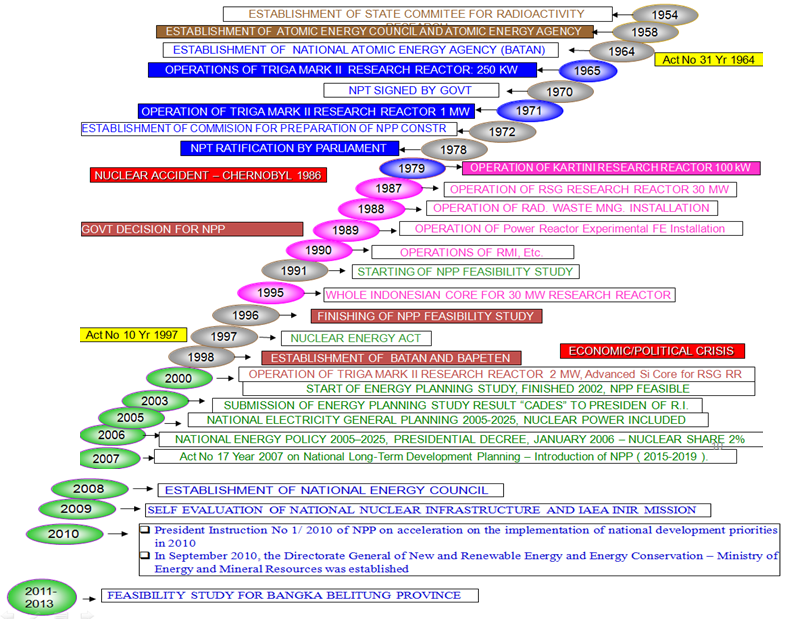
FIG. 4. Historical activities related to NPP programme.
In 2000–2002, the Indonesian Government performed an Energy Planning Study (Comprehensive Assessment of Different Energy Sources, CADES). This study involved related institutions and ministries, and was reviewed by IAEA. The result of this study was submitted to President Abdurrahman Wahid by IAEA Director General Mohammad ElBaradei in 2003. Based on the result of this study, a NPP in Indonesia was planned to operate beginning in 2016.
In the National Electricity General Plan (2005–2025), nuclear sources shall contribute to electricity generation. In Presidential Decree No. 5 of 2006 on National Energy Policy (2005–2025), the target for the optimum energy mix in 2025 set the contribution of biomass, nuclear, hydro, solar, and wind at more than 5% of total national energy supply. In addition, in accordance with Act No. 17 of 2007 on National Long Term Development Planning, nuclear energy should be implemented during 2015–2019.
In 2009, Indonesia prepared, developed and conducted a self-evaluation of the status of national nuclear infrastructure development. Furthermore, the Integrated Nuclear Infrastructure Review (INIR) Mission by the IAEA to review the status of Indonesia’s national nuclear infrastructure was conducted on 23–27 November 2009. The conclusion of INIR mission showed that Indonesia had done extensive preparatory work on most infrastructure issues that would allow the country to make the decision to further consider introduction of nuclear power, i.e. to go from Phase 1 to Phase 2 in the milestone methodology defined by the IAEA.
A comprehensive feasibility study was carried out over three consecutive years from 2011 to 2013 in Bangka Island, Bangka Belitung Province by the Indonesian Government through BATAN and PLN, assisted by both domestic and international consultants. In this study, two selected candidate sites were identified in Bangka Island, i.e. Bangka Barat Regency and Bangka Selatan Regency. Both selected candidate sites are feasible areas for NPPs to be built.
The Ministry of Energy and Mineral Resources is preparing a White Paper regarding a 5 000 MWe NPP in Indonesia. It is intended to be a source of information and reference for all stakeholders in the decision for the construction of NPPs in Indonesia.
2.1.2. Current Organizational Chart(s)
In order to implement a nuclear energy programme, Indonesia so far has not decided to establish a nuclear energy programme implementing organization (NEPIO). It should be noted that some available institutions, such as the National Nuclear Energy Agency (BATAN), Ministry of Energy and Mineral Resources, Ministry of Environment, Ministry of Research and Technology, Ministry of Industry, Nuclear Energy Regulatory Agency (BAPETEN), universities and State Electricity Company have played essential roles similar to those of an NEPIO.
The Ministry of Energy and Mineral Resources has the role in energy and electricity policy, the Ministry of Research and Technology in science and technology policy, the Ministry of Environment in site and environmental policy, while the Ministry of Industry has this role in national industry and technology transfer policy.
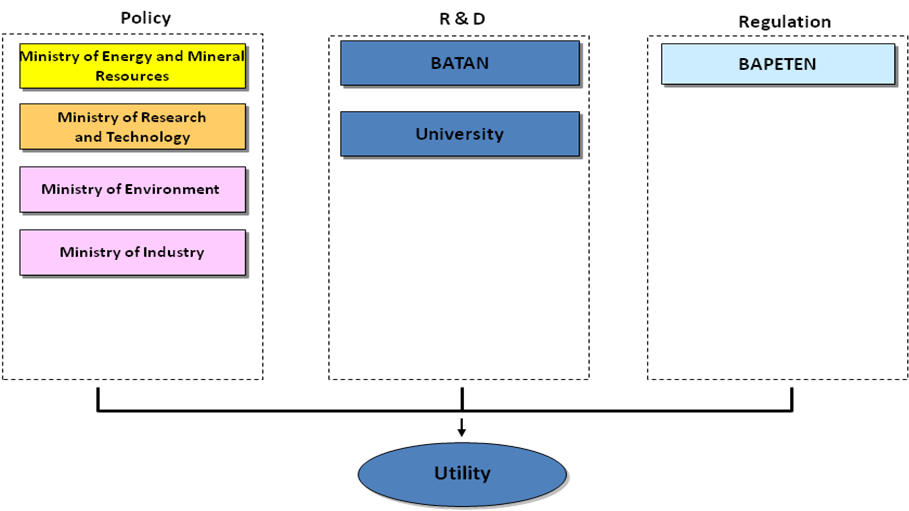
FIG. 5. Institutions involved in nuclear power programme.

FIG. 6. Responsible institutions and their scope of work.
BATAN collaborated with universities that have a role in doing related research and development, including technical consultancy, human resources and training, information and socialization and site preparation. BAPETEN has the role of regulatory body in nuclear regulation and licensing.
BATAN, in cooperation with other relevant government institutions, aims to prepare, develop and conduct a self-evaluation on the national status of 19 basic elements of infrastructure of NPP development. This was started in 2009. Figure 6 shows the responsible institutions and the scope of their work in preparation of infrastructure for a nuclear power programme.
2.2. Nuclear Power Plants: Overview
2.2.1. Status and Performance of Nuclear Power Plants
Not applicable.
2.2.2. Plant Upgrading, Plant Life Management and Licence Renewals
Not applicable.
2.2.3. Permanent Shutdown and Decommissioning Process
TABLE 5. STATUS AND PERFORMANCE OF NUCLEAR POWER PLANTS
| Reactor unit | Shutdown reason | Decommissioning strategy | Current decommissioning phase | Current fuel management phase | Decommissioning licence | Licence terminate year |
| n.a. | n.a. | n.a. | n.a. | n.a. | n.a. | n.a. |
2.3. Future Development of Nuclear Power Sector
2.3.1. Nuclear Power Development Strategy
Although the Government of Indonesia has not taken a decision yet, Indonesia actively prepared the first NPP development programme feasibility study and other infrastructure investigative activities.
Indonesia is considering a NPP project through an open bid mechanism. The type of contract for the first NPP is a turnkey approach. Regarding the nuclear fuel cycle, an open fuel cycle is the preferred option. According to BAPETEN Chairman Regulation No. 4/2009 on Nuclear Reactor Decommissioning, the owner has responsibility for decommissioning the NPP, including a provision for financial guarantees.
Yet, specific plans are still needed for national strategy implementation. The nuclear infrastructure is undergoing development through many related institutions, based on their tasks.
The government plans to develop a roadmap for nuclear energy development. Further explanation of nuclear energy as a last resort in national energy policy will be included in this roadmap for the implementation of nuclear power plants, which will outline technological aspects, fuel type, location, safety, financing, and human resources readiness, along with a multicriteria analysis. Activities and coordinating institutions for roadmap development are shown in Table 7.
TABLE 6. ACTIVITIES AND COORDINATING INSTITUTIONS FOR ROADMAP DEVELOPMENT
| No. | Activities | Coordinating institution |
| 1 | Research on the development of nuclear technology as well as economic and safety aspects | Ministry of Research Technology and Higher Education |
| 2 | Encourage the mastery of nuclear technology in line with the latest developments in nuclear technology advances in the world | Ministry of Research Technology and Higher Education |
| 3 | Carry out a multicriteria analysis of NPP implementation covering urgency, scale, supply assurance, energy supply equilibrium, carbon emission reduction, safety factors, and economy of scale by involving views from various stakeholders | Ministry of Energy and Mineral Resources |
| 4 | Develop roadmap of nuclear power plant implementation as the last option in the national energy development priority | Ministry of Energy and Mineral Resources |
| 5 | Build international cooperation related to the study of nuclear power plant development | Ministry of Energy and Mineral Resources |
TABLE 7. PLANNED NUCLEAR POWER PLANTS
| Station/project name | Type | Capacity | Expected construction start year | Expected commercial year |
| n.a. | n.a. | n.a. | n.a. | n.a. |
2.3.2. Project Management
Construction, operation and decommissioning of a nuclear reactor shall be performed by the responsible party, including a state company, cooperative, and/or private company, as mentioned in Act No. 10 of 1997 as well as Government Regulation No. 2 of 2014 on the Licensing of Nuclear Installation and Nuclear Fuel Utilization.
Regarding the operation of a NPP, the operator should apply for licence or permit from BAPETEN for site, construction, commissioning, operation and decommissioning activities.
The owner is responsible for the type of contract suitable to implement each NPP project. However, up to now, no organization has been established to be the owner of the first NPP. A study report on project management for the NPP done by BATAN and KHNP shows that a turnkey contract approach is appropriate for the first NPP project.
Local participation in the construction of a nuclear power plant should be maximized. The national industry capability shows that the local participation rate is about 35% for the first NPP and is targeted to increase from 35% to 80% respectively from Step 1 up to Step 5 (Fig. 7).
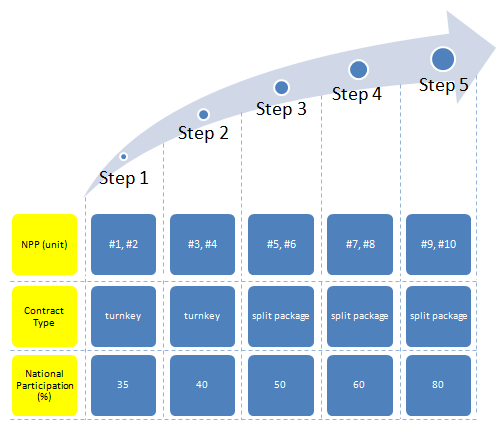
FIG. 7. Rate of national participation.
To gradually increase the local participation rate from 35% to 80%, the nuclear capability should be improved in the following areas: project management and engineering, other mechanical plant, electrical system, instrumentation and control, turbine island equipment, waste management system, fuel handling system, reactor containment facilities and the nuclear steam supply system (NSSS) auxiliary system.
Policies and requirements for purchasing nuclear equipment and services are not considered yet, but they should follow existing regulations.
2.3.3. Project Funding
The funding scheme for the NPP project in Indonesia is still under consideration. There are three kinds of NPP funding schemes, i.e. conventional scheme, build–operate–transfer (BOT) scheme including its variants (build–own–operate (BOO)/build–lease–transfer (BLT)), and counter trade scheme. A study undertaken by BATAN, PLN and Korea Nuclear and Hydro Power (KHNP) proposed a financing scheme and ownership structure for the first NPP in Indonesia. The funding for the construction of the first NPP may be a combination of a long term loan and equity. The loan would be used mostly to finance procurement of foreign contents, most likely obtained from ECA (Export Credit Agency) and a commercial bank through a loan agreement with the “NPP company” that could be owned by the government. Most of the equity portion would be used to finance local capital expenditures, such as land acquisition, professional fees, mobilization, certification, etc. The equity will be sourced partly from the public utility’s own funds, which might be PLN or another state owned enterprise/company, and from private investors who can become partners.
Funding for spent fuel handling, waste management, decommissioning and final disposal is the responsibility of the owner.
2.3.4. Electric Grid Development
Presently, an integrated electrical grid system exists in Java–Bali–Madura and Sumatera. The Java–Bali–Madura system is interconnected with 500 kV and 150 kV lines, while Sumatera is interconnected with 275 kV and 150 kV lines. Power transmission in Jawa–Bali and Sumatera will be integrated. PT PLN plans to expand the interconnection project through a high voltage direct current (HVDC) electricity transmission system. The combining of the two trusted interconnections is expected to facilitate cheap and efficient energy use. The interconnection system will be designed to distribute 3 000 MW from Sumatera to Jawa–Bali. It will consist of an AC to DC power converter station in Muara Enim, South Sumatera. DC power will then be converted to AC (inverter station) in Bogor, West Java. In case of Bangka NPP availability, this power transmission integration will ease the electricity distribution from Sumatera to Java.
Currently, in Kalimantan Island, a 150 kV line interconnects the provinces of Central Kalimantan, South Kalimantan and East Kalimantan. However, West Kalimantan province is still isolated from the other provinces.
2.3.5. Sites
There are several locations in Indonesia that were identified as potential sites for NPPs. Figure 8 shows the location of each site and recent status regarding surveys of the site: Muria Peninsula, Banten, East Kalimantan, Bangka Island, West Kalimantan and Batam Island. Specifically for Batam Island, a site presurvey was started in 2015. All of the potential sites were located in coastal areas owing to cooling water source availability.
In conducting the site survey and evaluation, IAEA guidance and BAPETEN regulations related to the safety and non-safety aspects and other considerations are used as the basis for safety and non-safety analysis.
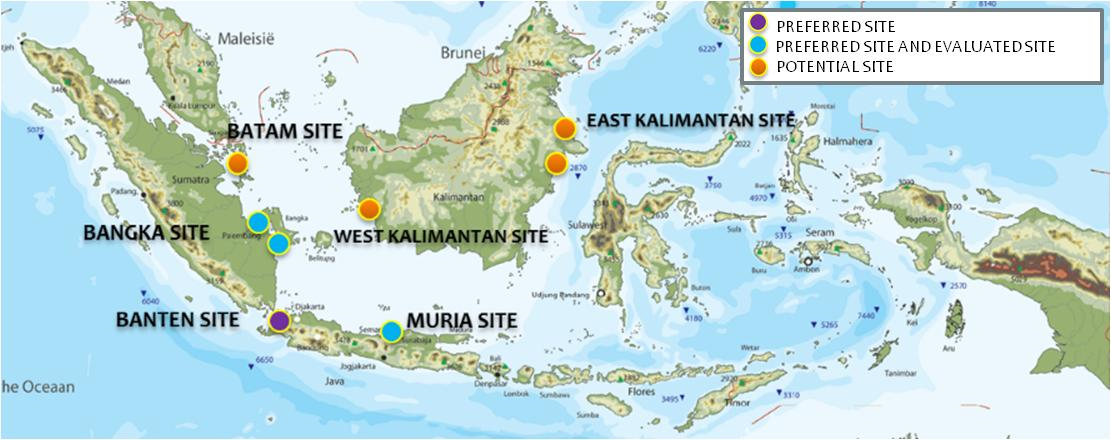
FIG. 8. Current status of NPP site study.
Muria Site
In particular, a feasibility Study for the Muria Peninsula was completed in 1996, identifying three candidate sites: Ujung Lemahabang (ULA), Ujung Watu (UW) and Ujung Grenggengan (UG). Two sites were preferred, namely ULA and UW. Site evaluation of the ULA preferred site has already been done by NEWJEC in 1991–1996, while for UW preferred site, the evaluation is not done yet. Nonetheless, international guidance and national regulation give rise to the necessity of further intensive investigation of the ULA site — mainly volcanology, geotechnical and seismotectonic aspects. Figure 9 shows the transportation infrastructure of the Muria site.
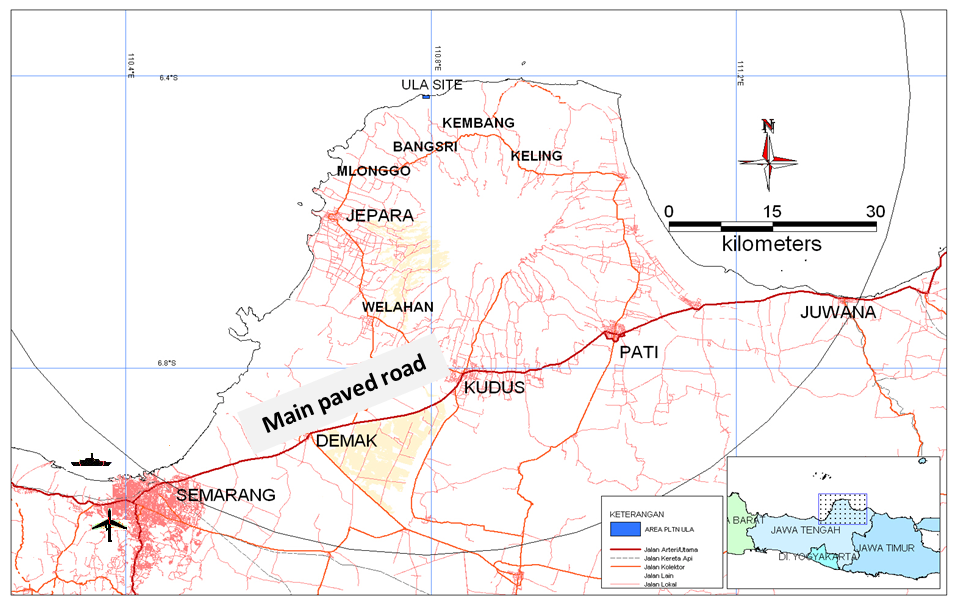
FIG. 9. Transportation infrastructure of Muria site.
Banten Site
Based on a preliminary study from 2008 until now, there are two potential sites in Banten, namely Pulo Panjang and Kramatwatu-Bojonegara. This study covers regional and near-regional analysis.
The characteristics of both sites are as follows:
Safe from external hazard (volcanic, surface faulting, seismicity, extreme meteorology and coastal flooding);
Not located in an area at risk of pyroclastic density current (PDC) from a capable volcano;
Distance from supposed capable faults > 5 km;
Peak ground acceleration (PGA) value < 0.4 g;
Not an area that has tornado events or tropical cyclones;
Not flooded by tsunami waves caused by historical tectonic earthquake and Krakatoa volcanic activity (1883);
Not inundated by sea level rise due to global warming (eustacy) in 100 year projection;
Not in urban and population centres and have a distance to outer border of population centre > 1 km;
Safe from human activities that have potential safety threat.
Figure 10 shows transport infrastructure of the Banten site.
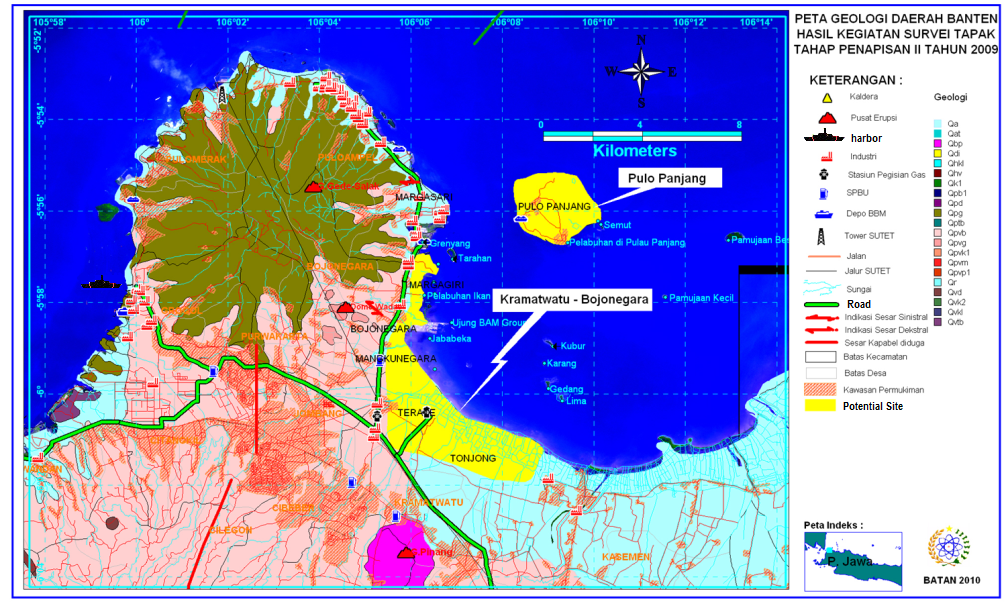
FIG. 10. Transport infrastructure at Banten site.
Bangka Site
The feasibility study carried out in Bangka Island consisted of three phases in three consecutive years from 2011 to 2013. Based on the study, there are two areas of interest in the Bangka site: Site 1 (Teluk Manggris-Tanah Merah, Mentok, West Bangka Regency), and Site 2 (Tj. Berani-Tj Krasak, Sebagian, Simpang Rimba, South Bangka Regency). A licensing document consisting of Site Data Report (SDR), Site Evaluation Report (SER), Site Data Information (SDI), concept of Environmental Impact Analysis Report (EIAR), and draft of NPP Master Plan was done in 2013.
Area 1 can be reached from Pangkal Pinang through Kelapa by paved road of approximately 140 km, then for about 4 to 6 km by unpaved road, of which only 3 km can be accessed by car and the rest by motorcycle or by a four wheel drive vehicle. Meanwhile, Area 2 can be reached from Pangkal Pinang through Sungai Selan, Bangka Kota, Simpang Rimba, Permis Village, Rajik Village and Sebakin Village by paved road of 83.5 km. There are 5 major harbours and one medium airport. Bangka site transport infrastructure is provided in Fig. 11.
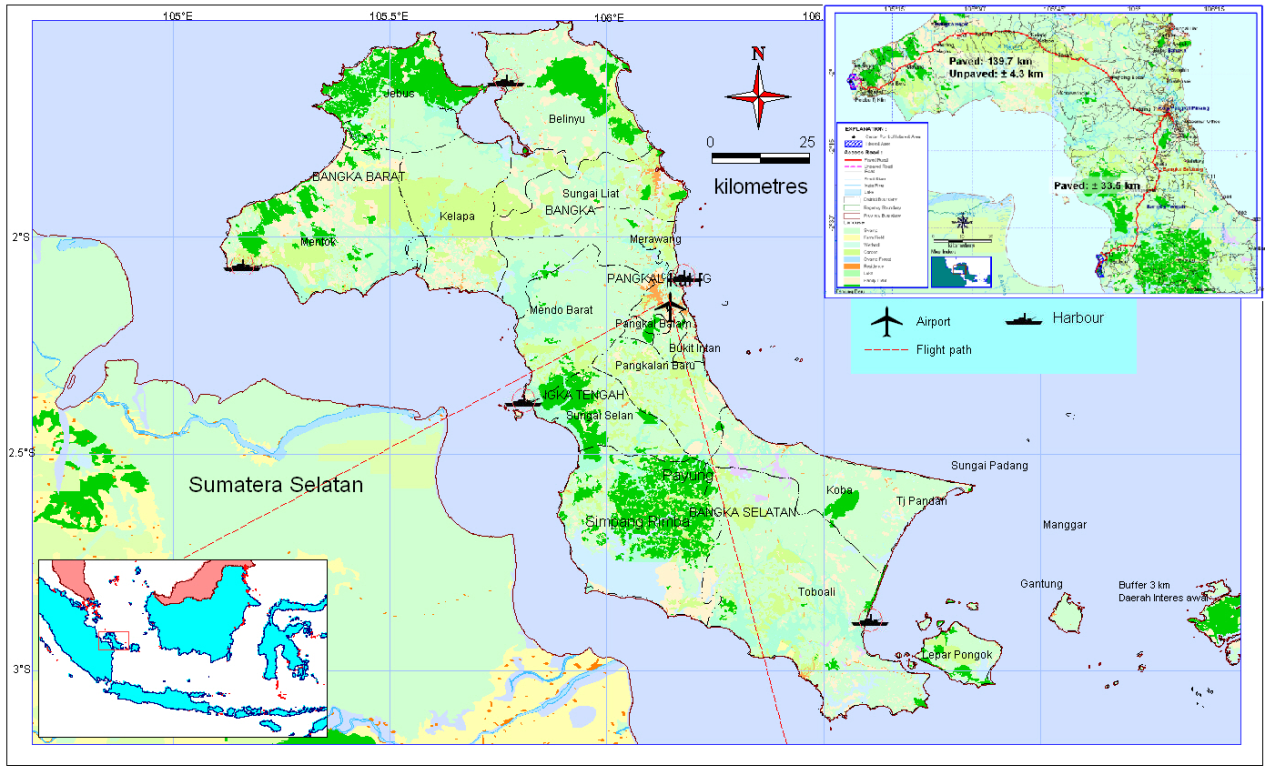
FIG. 11. Bangka site transport infrastructure.
Based on the feasibility study performed, West and South Bangka are considered feasible for a NPP site due to the conditions for site acceptance.
The ultimate capacity for the West Bangka site is 6 × 1000 MWe, and that for the South Bangka site is 4 × 1000 MWe.
West Kalimantan Site
Based on the conformity analysis of Ketapang and Kayong Utara Regency, there are three areas of interest located in Ketapang Regency and another area of interest located in Kayong Utara Regency. By using a weighting approach, these areas of interest are ranked as follows: Kendawung District (Ketapang Regency) as first rank, Sukadana District (Kayong Utara Regency) as second rank, and Matan Hilir Selatan District (Ketapang Regency) as last rank.
From a geological point of view, each of the potential sites has a relatively stable formation, with reasonably similar lithology conditions and a safe distance from volcanic hazards. More specifically, in Kendawangan Subdistrict, granite and volcanic rock was found. The land cover of Ketapang Regency is dominated by peat with a depth of more than 3 meters.
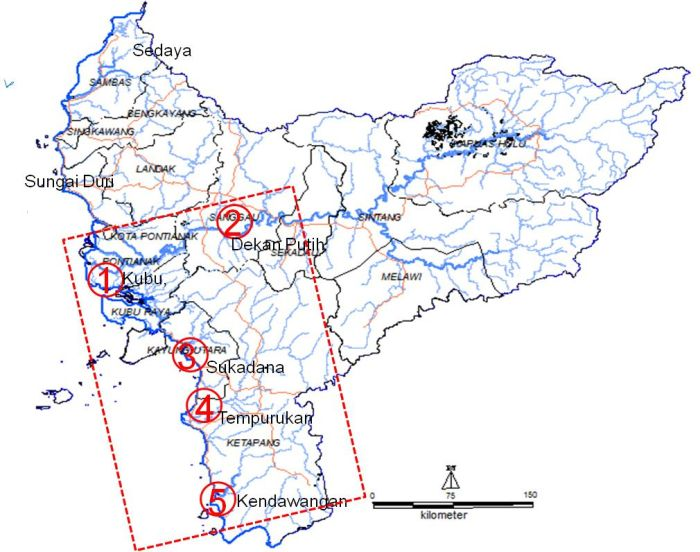
FIG. 12. Potential NPP site at Ketapang Regency.
East Kalimantan Site
Pre-survey activities in 2007–2008 covered 8 potential sites, namely: (1) Tanjung Prapat and Tanjung Saban, Paser Regency; (2) Babulu Laut, Penajam Paser Utara Regency; (3) the industrial area of Kariangau, Balikpapan; (4) Sandaran Subdistrict, Kutai Timur Regency; (5) Sanggata Subdistrict, Kutai Timur Regency; (6) Pulau Derawan Subdistrict, Berau Regency; (7) Talisayan, Berau Regency and (8) Biduk-biduk, Berau Regency. In 2009, pre-survey activities only covered Balikpapan, Kutai Timur Regency and Berau Regency, which yielded four interest areas, namely: (1) Tanjung Batu, Berau Regency; (2) Talisayan, Berau Regency; (3) Tanjungpagar, Kutai Timur Regency and (4) Kariangau, Balikpapan.
Generally, all the potential sites located in East Kalimantan are safe from volcanic and seismic hazards. From a lithological point of view, Balikpapan is composed of Miocene–Pliocene and Holocene rocks. Meanwhile, Kutai Timur Regency is constituted by Eocene–Pliocene rocks. A compact bedrock has been found in Berau Regency that consists of Domaring Formation and Sajau Formation. Alluvial sedimentation has dispersed along the coastal line of each potential site. Berau Regency has several major rivers, namely the Berau, Kelay and Segah rivers. These rivers have a potential to cause river flooding at the estuary due to the slope morphology.
Balikpapan is a city with well developed infrastructure. Road infrastructure is mostly well interconnected within the region. There is an airport, Sepinggan airport, which up to now was the main access point to enter East Kalimantan Province.
Land transportation at Kutai Timur Regency consists of several routes. The condition of the road along Samarinda Sangatta is fairly good as a main route. For air transportation, there are two airports: Kaltim Prima Coal (KPC) airport at Tanjung Bara and Pertamina airport at Sangkimah. There is also an existing seaport and harbour in the area.
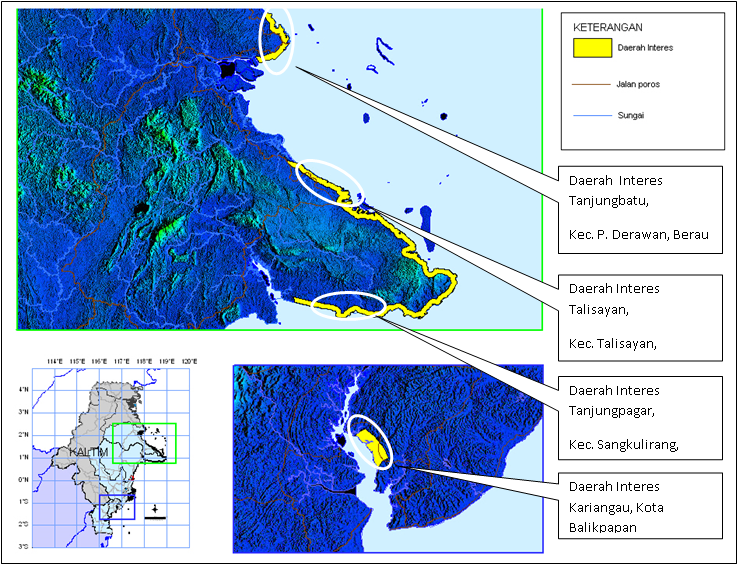
FIG. 13. Potential sites at East Kalimantan.
Meanwhile, at the Berau Regency, land transportation from Kutai Timur Regency is fairly good and is used as the province’s main route. Sea transportation is used to connect to other regions such as from Kota Tanjung Batu to Batu Putih. This route is relatively more comfortable and economical. Air transportation at the Berau Regency serves regional movement from Berau to Balikpapan, Tarakan, Tanjung Selor and Samarinda through Kalimarau airport (4 km from Tanjung Redeb).
Batam Site
With the intention of developing alternative energy infrastructure as an effort to increase investment opportunity, Batam Indonesia Free Zone Authority (BIFZA), in cooperation with National Nuclear Energy Agency (Badan Tenaga Nuklir Nasional, BATAN), plans to develop nuclear technology, especially in the energy sector. Following up on this plan, a series of preliminary studies on nuclear power plant development was carried out, which included siting reviews. In order to identify potential sites, pre-survey activities were performed in 2015 covering Batam, Rempang and Galang islands, also called the BARELANG islands. The BARELANG islands are located at 0°25'29?–1°15'00? N and 103°34'35?–104°26'04?E as shown in Fig. 14. The area covered by the BARELANG islands is 715 km2, which consists of Batam Island (415 km2), Rempang Islands (165.83 km2), Galang Island (80 km2) and Galang Baru Island (32 km2).
The pre-survey activities were carried out using secondary data which include DEM satellite imagery of the BARELANG islands, morphological map, geological map, hydrogeological map, etc. At first, general criteria were applied as follows:
Maximum distance to the shoreline is 3 km;
Not at a site that is considered a permanent swamp;
Not at a site that is designated as a protected/conservation forest;
Minimum distance to the outside boundary of dense population area (> 25 000 people) is 1 km;
Maximum distance to the airport is 8 km;
Afterward, in accordance with IAEA safety standards, specific criteria were then applied, which include capable fault and pyroclastic flow identification. In terms of tectonic and seismicity, BARELANG islands is considered a tectonically non-active area. There is no active fault identified. Nevertheless, based on a geological map published by Indonesia Geological Agency, faulting exists in Tanjungkerotang Formation (Tmpt) on Rempang Island and the northern part of Galang Island (Fig. 15).
The pre-survey activities yielded five interest areas: Kelurahan Rempang (Tanjung Kelingking)–Rempang Island, and Kelurahan Sijantung–western coast of Galang Island, Tanjung Batu and Tanjung Ramai (Desa Karas)–eastern coast of Galang Island.
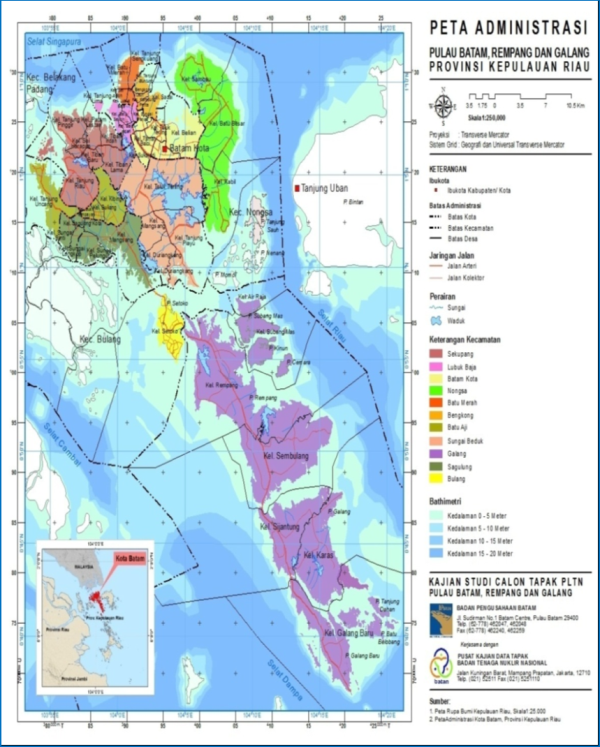
FIG. 14. Potential sites at Batam.
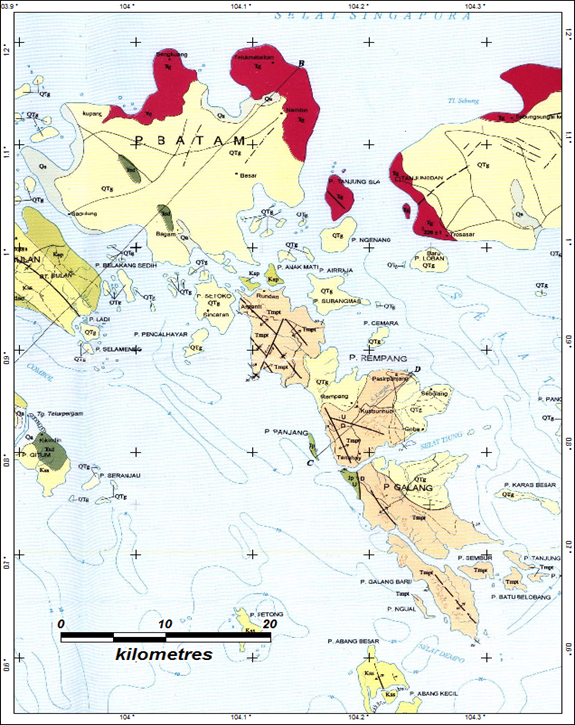
FIG. 15. Potential sites at Batam.
2.3.6. Public Awareness
In order to survey public perception concerning utilization of NPPs in Indonesia, a poll of 3 000 respondents was conducted in November 2010, resulting in 59.7% agreement on the use of NPPs in Indonesia, and with 26.1% who did not agree and 14.2% who abstained. After the Fukushima Daiichi NPP accident in 2011, a poll was conducted with the same number of respondents and the result decreased to 49.5% who were in agreement. In 2012, a poll involving 5 000 respondents was conducted and it showed that public acceptance increased to 52%. A poll in 2013 showed that public acceptance for utilization of NPPs in Indonesia increased to 60.4%. A poll in 2014 found that public acceptance for utilization of NPP in Indonesia significantly increased, and 72% were found to be in agreement. In 2015, another survey was produced that indicated that 75.3% support the construction of nuclear power plants. Results of a poll commissioned by an independent survey agency in 2016 reveal that 77.53% of Indonesian people agree with the government’s plan to develop nuclear power plants.
2.4. Organizations Involved in Construction of NPPs
Not applicable.
2.5. Organizations Involved in Operation of NPPs
Not applicable.
2.6. Organizations Involved in Decommissioning of NPPs
Not applicable.
2.7. Fuel Cycle Including Waste Management
Based on Act No 10 of 1997 on Nuclear Energy, general surveys, explorations and exploitations of nuclear material ore as well as the production and/or procurement of raw materials for manufacturing nuclear fuel shall be performed by BATAN or in cooperation with a state company, cooperative or private company. BATAN shall also perform non-commercial production of nuclear fuel and radioisotopes, while the commercial production shall be performed by a state company, cooperative and/or private company.
Act 10 of 1997 stipulated that radioactive waste management shall be performed by BATAN. Low level and intermediate level radioactive waste generated shall be collected, segregated, treated and temporarily stored before being transferred to BATAN. High level radioactive waste (i.e. spent fuel) generated shall temporarily be stored for a period not less than the lifetime of nuclear reactor. A final repository for high level radioactive wastes shall be provided by BATAN.
2.8. Research and Development
2.8.1. R&D Organizations
Research and development (R&D) in nuclear science and technology are mainly implemented by BATAN. Nuclear R&D activities are classified into reactor safety, radiation safety, environmental safety, radiation and radioisotope applications, and radioactive waste management. R&D activities are implemented in several nuclear complexes as described in the following paragraphs.
SERPONG NUCLEAR COMPLEX
There are many centres in the Serpong Nuclear Complex for research and development and engineering in nuclear science and technology that have been built with the objectives to support development of the nuclear industry and for preparation, development as well as operation of nuclear power plants in Indonesia.
The development of installations and laboratories of the Serpong Nuclear Complex was conducted in three phases beginning in 1983 and fully completed in 1992. The area covers about 25 hectares and is located in the National Centre for Research of Science and Technology (PUSPIPTEK), Serpong.
The main facility in the area is the GA. Siwabessy Multipurpose Research Reactor with a power of 30 MW. The installation is used for Production of Research Reactor Fuel Elements, Radioisotopes and Radiopharmaceuticals Installation, Experimental Fuel Element Installation, Radioactive Waste Processing Installation, Radiometallurgy Installation, Reactor Safety and Engineering Installation, Facility for Development of Informatics and Computation, Nuclear Mechanic–Electronic Installation, Neutron Spectrometry Installation, as well as Storage for Spent Fuel Elements and Contaminated Materials Installation.
BANDUNG NUCLEAR COMPLEX
The Bandung Nuclear Complex was initially constructed in the early 1960s on an area of 3 hectares and is where the first research reactor in Indonesia was built. The activities conducted cover the utilization of the reactor for research and fostering of expertise, R&D on basic materials, radioisotopes and labelled compounds, instrumentation and radiometry analysis techniques and supervision of occupational radiation safety and environment.
In addition, nuclear medicine in Indonesia was first developed in Bandung Nuclear Complex. The activities in nuclear medicine have since then been further developed in several hospitals in Indonesia.
In order to support the R&D activities, the Bandung Nuclear Complex utilizes various facilities, including the Triga Mark II Reactor which started with a power of 250 kW in 1965. The power of this reactor was increased to 1000 kW in 1971 and further to 2000 kW in 2000.
Other facilities in this area are the laboratories for physics, chemistry and biology, production of isotopes and labelled compounds.
YOGYAKARTA NUCLEAR COMPLEX
The Yogyakarta Nuclear Complex was established in 1974 on 8.5 hectares. The Centre for Science and Accelerator Technology of and the Polytechnic Institute of Nuclear Technology are located within this area.
The activities conducted cover R&D in nuclear physics, chemistry, technology of low and medium energy particle accelerators, process technology, analysis of nuclear materials and reactors, as well as the use of the reactor for research and fostering of expertise.
In addition, supervision of occupational radiation safety and of environmental radioactivity is also conducted. Meanwhile, the Polytechnic Institute of Nuclear Technology conducts programmes of education in the field of nuclear science and technology.
The facilities in this area are the Kartini Research Reactor with a power of 100 kW, complemented with a subcritical assembly, a laboratory for pure materials research, accelerators, laboratories for nuclear physics and chemistry, a work health and safety facility, library facilities, as well as laboratory facilities for education.
PASAR JUM'AT NUCLEAR COMPLEX
The Pasar Jum'at Nuclear Complex was built in 1966 on an area of about 20 hectares. In this area, the Centre for Application of Isotopes and Radiation, Centre for Technology of Radiation Safety and Metrology, Centre for Technology of Nuclear Geology, Centre for Education and Training and Centre for Dissemination and Partnerships are located.
The following facilities, among others, are in this area: three units of Co-60 Gamma Irradiators, two electron beam machines, laboratory for uranium processing, radiation measuring equipment, chemistry, biology, process and hydrology, education and training facility as well as a permanent exhibition for nuclear science and technology.
MONITORING STATIONS FOR MICROEARTHQUAKES AND METEOROLOGY JEPARA (CENTRAL JAVA) AND BANGKA ISLAND
Since 1982, a monitoring station for microearthquakes and meteorology was built and operated in the Ujung Watu village in Jepara (Central Java). The microearthquake monitoring station records the data on volcanic as well as tectonic earthquakes, whereas the meteorology station records air pressure, wind speed and direction, air temperature, humidity and solar radiation.
In addition, since 2011 an identical facility has been operated on Bangka Island to record the data on microearthquakes and meteorology on the Bangka site. There are 10 microearthquake monitoring stations and two meteorology monitoring stations.
2.8.2. Development of Advanced Nuclear Technologies
Indonesia participates in the development of nuclear reactor systems through the INPRO project. There is also a plan to develop HTR design with cogeneration purposes.
2.8.3. International Cooperation and Initiatives
Indonesia has signed a number of international agreements as well as conducted bilateral and multilateral cooperation in the field of nuclear power development. A complete list of international agreements and cooperative activities is provided in Appendix 1.
2.9. Human Resources Development
A human resource development (HRD) plan identifying the human resources needed by organizations implementing a nuclear energy programme was addressed in the study on the HRD programme and HRD blueprint carried out in 2008.
The IAEA’s Technical Reports Series No. 200 has been used to identify competences and human resources needed for future organization of NPPs. More detailed reviews and analyses on competences and human resources needed for future organization and a blueprint of a human resources development (HRD) programme and concept of nuclear training centre (NTC) facilities are being conducted by interdepartmental organizations, including MEMR, BATAN, Department of Labor and Transmigration, BAPETEN, and Ministry of Research and Technology, as indicated by Decree of ETC-MEMR Chairman No. 105K of 2008 and Decree of BATAN Chairman No. 071 of 2009. The stakeholders involved are BATAN, BAPETEN, MEMR, Ministry of Research and Technology, Department of Labor and Transmigration, and universities.
For the human resources development programme, BATAN and related institutions sent personnel to universities (in Indonesia or abroad) to obtain graduate/doctoral degrees and sent personnel abroad to notable NPP companies such as General Electric, Westinghouse Companies, Atomic Energy of Canada Limited, Mitsubishi, Korea Hydro and Nuclear Power (KHNP), Korea Atomic Energy Research Institute (KAERI) and Korea Power Engineering Company (KOPEC) etc. to participate in their NPP design activities.
BATAN has established the Education and Training Centre (PUSDIKLAT), which is responsible for the implementation of education and training programmes, especially in nuclear science and technology related to BATAN’s competency. The development programme is oriented towards providing well educated and well trained personnel in the fields of research, development and application of nuclear technology, as well as to promoting nuclear science and technology to the public, especially industrial society, through education and training programmes.
Moreover, BATAN has also established a higher education institute called College of Nuclear Technology (STTN) based on Presidential Decree No. 71 of 2001. STTN is an official education institute carrying out nuclear science and technology human resources development programmes through carefully crafted four year education. STTN has two major study programmes: Nuclear Techno-Chemistry and Nuclear Techno-Physics.
In addition, for human resources development, BATAN established cooperation with Gadjah Mada University, University of Indonesia, and Bandung Technology Institute in various fields of study.
Indonesian personnel have had many experiences in construction and operation of non-nuclear power plants, such as coal power plants with capacities from 35 MWe to 600 MWe. BATAN staff also have had experiences in construction and operation of research nuclear reactors, i.e. Kartini Reactor in Yogyakarta (100 kWe), Triga Mark II Reactor in Bandung (2 MWe) and GA. Siwabessy Reactor in Serpong (30 MWe).
2.10. Stakeholder Communication
BATAN and the Ministry of Research and Technology have undertaken several activities in public information and education.
Public information and education are carried out for disseminating information on the nuclear power programme to various target audiences, which include parliamentary representatives, government executives, politicians, journalists and editors, social organizations (including women’s associations), local representatives and religious leaders, professional groups (engineers, ecologists, sociologists, culture researchers, artists etc.), schools/universities/colleges (students, teachers, lectures) and the armed forces.
The means of disseminating public information and education are through several periodic events including exhibitions; opening events for information centres at nuclear facilities involving high ranking officials; visits to nuclear research or power plants for decision makers (parliamentary representatives, civil servants); and for opinion leaders (newspapers, radio, TV), a national seminar on nuclear technology and energy, with invited speakers from various domestic and overseas institutions.
2.11. Emergency Preparedness
The operation of the nuclear power plant in the region in which it is located will impact the workers and public. The potential sources of radiological exposure from the plant are identified and the severities of the possible resulting hazards are evaluated to derive the appropriate design bases for the plant. They are to be monitored and periodically assessed over the lifetime of the plant to ensure that consistency with the design assumptions is maintained.
For such purposes the recommendations and guidelines from BAPETEN Chairman Decree No. 1 of 2010 on Emergency Preparedness and Response, and IAEA Safety Standards Series No. GSR Part 7, Preparedness and Response for a Nuclear or Radiological Emergency are being applied.
Referring to BAPETEN Chairman Decree No. 1 of 2010, West & South Bangka is included in Radiological Threat Category 1, namely, installation or facility with very high potential risk of generating radioactive releases causing severe deterministic effects off-site. Emergency zones and radii for Radiological Threat Category 1 are specified below:
| Installation/facility | Radius of precautionary action zone | Radius of urgent protective action planning zone | Radius of food restriction planning |
| Installation/facility with Radiological Threat Category I | |||
| Reactor > 1000 MWt | 3–5 km | 25 km | 300 km |
In order to protect both NPP workers and the public surrounding the NPP site in the event of a NPP accident, an emergency preparedness programme and response shall be developed before NPP operation. The emergency preparedness programme will cover: introduction, infrastructure, control function, references and abbreviations. Detail of the emergency preparedness programme should follow the BAPETEN regulation.
The organization will cover three levels of emergency response as follows:
Installation level. The responsible organization for the emergency response is the NPP operator.
Province level. The responsible organization for the emergency response is the head of the province’s disaster management agency (BPBD).
National level. If the accident affects a large area and its level indicates notification as a national disaster, the National Disaster Management Agency (BNPB) will be responsible for the emergency response.
3. NATIONAL LAWS AND REGULATIONS
3.1. Regulatory Framework
3.1.1. Regulatory Authority(ies)
Profile of the Regulatory Body
The Nuclear Energy Regulatory Agency (BAPETEN) is a non-department government institution which is under and responsible to the President. BAPETEN is responsible for implementing the surveillance of all activities relating to the use of nuclear energy in Indonesia through regulation, licensing and inspection in accordance with applicable laws and regulations. BAPETEN was founded on 8 May 1998 and began actively working on 4 January 1999.
The main task of BAPETEN is to conduct surveillance of all activities that use nuclear energy by managing regulation, licensing and inspections.
The functions of BAPETEN are:
Formulation of national policies in the field of supervision of the use of nuclear energy; preparation and creation of national plans and programmes in the field of supervision of nuclear energy utilization;
The management and preparation of regulations and the review of the implementation of nuclear safety, radiation safety, and security of nuclear materials;
Implementation of licensing and inspection of construction and operation of nuclear reactors, nuclear installations, nuclear materials facilities, and sources of radiation as well as the development of nuclear preparedness; implementation of cooperation in the field of monitoring of the use of nuclear energy by government agencies or other organizations both inside and outside of the territory of Indonesia;
Implementation of surveillance and control of nuclear materials; implementation of guidance and information concerning the efforts to ensure the safety and health of the workers and members of the public as well as environmental protection;
Implementation of the improvement of human resources development and quality in the BAPETEN; implementation of administrative guidance, control and supervision within BAPETEN environment;
Implementation of other tasks given by the President.
Role and Responsibility of the Regulatory Body
BAPETEN, as an independent regulatory body, has responsibility to ensure that any activity related to the use of any nuclear energy is performed to maintain the safety, security, and peace, as well as the health of the workers and the public, and also the protection of the environment. These are administered by:
Drafting and establishing nuclear safety regulations;
Controlling nuclear installations and nuclear materials through licensing and inspection systems that covered all stages of NPP establishment (from site evaluation to decommissioning stages);
Controlling the use of radioactive materials and other radiation sources through licensing and inspection systems.
Scope of Activities
Nuclear Energy Act UU No. 10 of 1997 explains the important supervisory function in protecting public health and the health of the environment: the creation of regulations, licensing and inspections. This supervisory function is the main activity carried out by BAPETEN.
Making Rules: BAPETEN is responsible for the creation of rules and safety regulations. Representing the government, BAPETEN cooperates with the House of Representatives in making government regulations in relation to the safe use of radiation sources. BAPETEN also assists the President of the Republic of Indonesia in making Presidential Decrees.
As a regulatory agency, BAPETEN has issued more than 30 recommendations and safety instructions in the use of nuclear energy. All regulations and instructions can be found on the BAPETEN web site.
Licensing: Use of radioactive materials and radiation emitting devices without prior permission of BAPETEN is prohibited. As of June 2005, BAPETEN had issued 3162 permits for industrial activities, 2958 permits for medical activities and 3383 working licences for Radiation Protection Officers. BAPETEN continues to try to raise awareness of radiation safety.
Inspection: BAPETEN conducts supervisory inspections to ensure compliance of the users with the safety regulations and provisions relevant to the permit conditions.
Organization of the Regulatory Body
BAPETEN is headed by a chairman assisted by two deputies and one executive secretary. It has seven directorates, two centres for assessment, three bureaus, an Internal Affairs department and an Education and Training Centre, as shown in Fig. 14. According to the regulation, the Chairman of BAPETEN is directly responsible to the President.
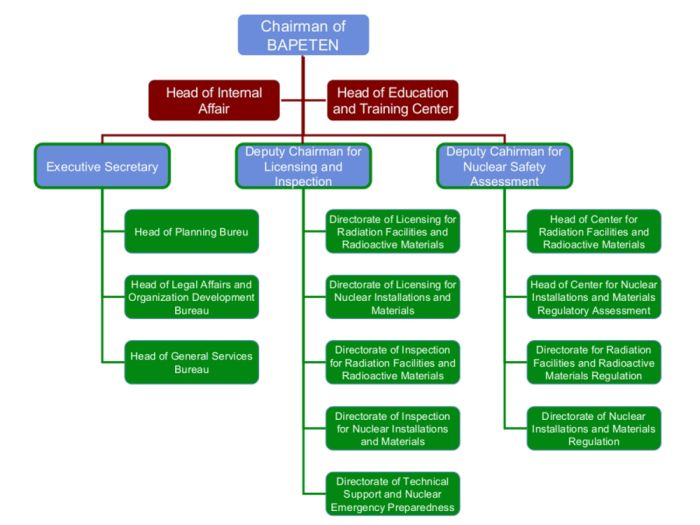
FIG. 16. Organization chart of the regulatory body.
3.1.2. Licensing Process
Based on Government Regulation (GR) No. 2 of 2014 on the Licensing of Nuclear Installation and Nuclear Fuel Utilization, which replaced Government Regulation No. 43 in 2006, the construction and operation of a nuclear reactor can be performed after obtaining a licence from BAPETEN. The licence will be issued in the following stages: Site Permit, Construction Permit, Operating Licence and Decommissioning Permit.
The diagram of the Entire Licensing Process is shown in Fig. 17.
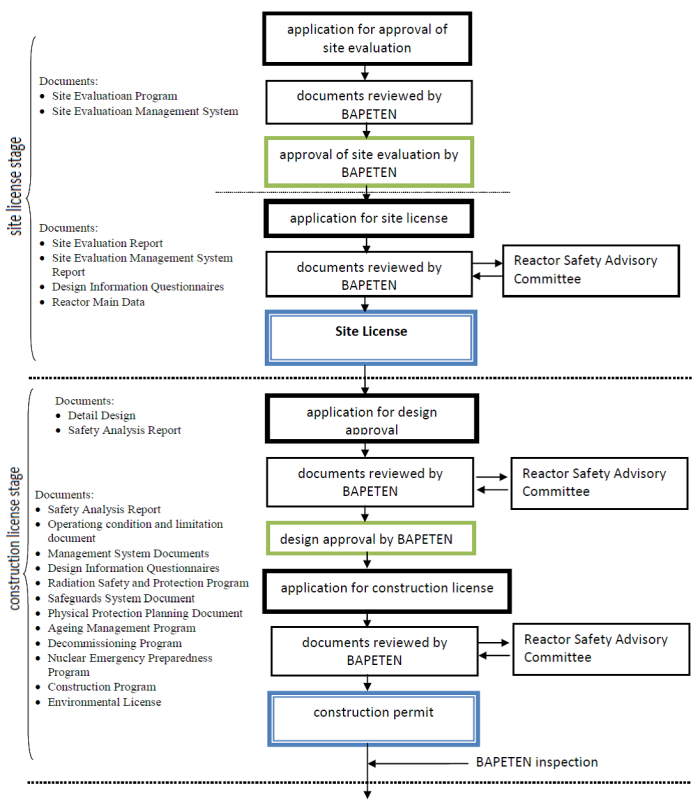
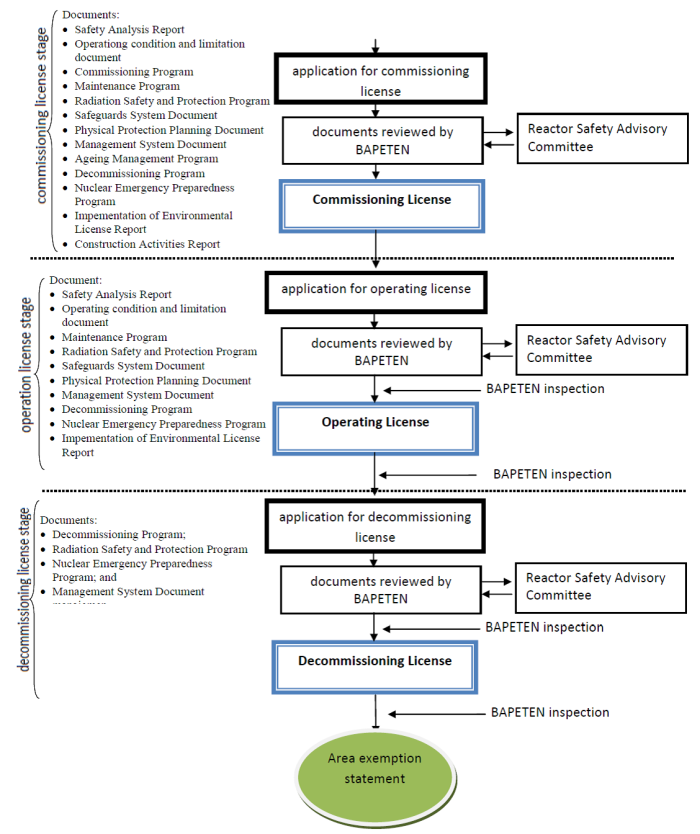
FIG. 17. Diagram of the entire licensing process.
The procedure for obtaining a licence consists of a five stage licensing procedure and evaluation period:
Site permit/licence (maximum 2 years);
Construction permit/licence (maximum 2 years);
Commissioning permit/licence (maximum 1 year);
Operating licence (maximum 2 years);
Decommissioning permit (maximum 1 year).
3.2. National Laws and Regulations in Nuclear Power
The highest regulation level in the hierarchy of regulation in Indonesia is the 1945 Constitution followed by Act, Government Regulation and Presidential Decree, and Ministry/Chairman of BAPETEN. Guides and standards form the lowest level.
A number of regulations regarding NPP establishment have been prepared as follows:
Acts
Act No. 10 of 2014 on Ratification of the International Convention for the Suppression of Acts of Nuclear Terrorism;
Act No. 1 of 2012 on Ratification of the Comprehensive Nuclear-Test-Ban Treaty;
Act No. 12 of 2011 on the Establishment of Legislations;
Act No. 30 of 2007 on Energy;
Act No. 25 of 2007 on Investment;
Act No. 17 of 2007 on National Long Term Development Planning;
Act No. 3 of 2002 on National Defence;
Act No. 10 of 1997 on Nuclear Energy;
Act No. 9 of 1997 on the Treaty on South East Asia Nuclear Weapon Free Zone;
Act No. 8 of 1978 on Ratification of NPT.
Government Regulations (GRs)
GR No. 2 of 2014 on the Licensing of Nuclear Installation and Nuclear Fuel Utilization;
GR No. 61 of 2013 on Radioactive Waste Management;
GR No. 54 of 2012 on the Safety and Security of Nuclear Installations and Nuclear Material;
GR No. 46 of 2009 on Limit of Liability for Nuclear Damages;
GR No. 29 of 2009 on the Procedures for Determining the Amount, Payment, and Remittance of Payable Non-Tax State Revenues;
GR No. 27 of 2009 on the Classification and Tariff of Non-Tax State Revenues for the Nuclear Energy Regulatory Agency;
GR No. 29 of 2008 on the Licensing on the Utilization of Ionizing Radiation Sources and Nuclear Materials;
GR No. 33 of 2007 on the Safety of Ionizing Radiation and the Security of Radioactive Sources;
GR No. 43 of 2006 on Nuclear Reactor Licensing;
GR No. 27 of 2002 on Radioactive Waste Management;
GR No. 26 of 2002 on Safety of Radioactive Material Transport;
GR No. 63 of 2000 on Safety and Health concerning Utilization of Ionizing Radiation;
GR No. 64 of 2000 on Licensing for Utilizing of Nuclear Energy;
GR No. 20 of 1994 on Investment.
Presidential Decrees
Presidential Decree No. 74 of 2012 on Nuclear Damage Liability;
Presidential Decree No. 85 of 2010 on the Ratification to the Joint Convention on the Safety of Spent Fuel Management and on the Safety of Radioactive Waste Management;
Presidential Decree No. 46 of 2009 on the Ratification to the Convention on Physical Protection of Nuclear Material;
Presidential Decree No. 106 of 2001 on Ratification of Convention on Nuclear Safety;
Presidential Decree No. 66 of 1999 on Radiation Risk and Subvention;
Presidential Decree No. 187 of 1998 on BATAN and BAPETEN Establishment;
Presidential Decree No. 82 of 1993 on Ratification of Convention on Assistance in the Case of a Nuclear Accident or Radiological Emergency;
Presidential Decree No. 81 of 1993 on Ratification of Convention on Early Notification of a Nuclear Accident;
Presidential Decree No. 80 of 1993 on the Ratification to the Amendment of Article VI of the Statue of the International Atomic Energy Agency;
Presidential Decree No. 49 of 1986 on Ratification of Convention on the Physical Protection of Nuclear Material.
BAPETEN Chairman Regulations (BCRs)
BCR No. 6 of 2014 on Nuclear Installation Site Evaluation for Meteorology and Hydrology Aspects;
BCR No. 3 of 2014 on the Preparation of Document of Environmental Impact Assessment in Nuclear Field;
BCR No. 8 of 2013 on Nuclear Installation Site Evaluation for Seismicity Aspect;
BCR No. 16 of 2012 on the Clearance Level;
BCR No. 12 of 2012 on the Implementation of Electronic System in Respect to the Framework of Indonesia National Single Window in the Nuclear Energy Regulatory Agency;
BCR No. 6 of 2012 on the Essential System Design for Computer Based Safety in Power Reactor;
BCR No. 3 of 2012 on the Management of Non-Tax Revenues in the Nuclear Energy Regulatory Agency;
BCR No. 2 of 2012 on the Protection Against Internal Hazard other than Fires and Explosions in the Design of Nuclear Power Plants;
BCR No. 1 of 2012 on the Provision Against Internal Fires and Explosion in the Design of Nuclear Power Plants;
BCR No. 10 of 2011 on the Management System for Nuclear Energy Regulatory Agency;
BCR No. 9 of 2011 on the Compliance Test for the X-Ray Radiology Diagnostic;
BCR No. 8 of 2011 on the Radiation Safety in the Uses of X-Ray Radiology Diagnostic and Intervention;
BCR No. 7 of 2011 on the Design of Emergency Power Supply System for Power Reactor;
BCR No. 4 of 2011 on the Safeguard System;
BCR No. 3 of 2011 on the Safety Design of Power Reactor;
BCR No. 6 of 2010 on the Health Monitoring for Radiological Workers;
BCR No. 4 of 2010 on the Nuclear Energy Facility and Utilization Activity Management System;
BCR No. 3 of 2010 on the Design of Handling and Storage System of Nuclear Fuel for Power Reactors;
BCR No. 1 of 2010 on Nuclear Emergency Responses and Preparedness;
BCR No. 9 of 2009 on Intervention Exposure from Technologically Enhanced Naturally Occurring Radioactive Material;
BCR No. 7 of 2009 on Radiation Safety in the Use of Radiography Industry Equipment;
BCR No. 6 of 2009 on Radiation Safety in the Utilization of Radioactive Materials and X-Ray and X-Ray for Gauging Equipment;
BCR No. 5 of 2009 on Radiation Safety in the Use of Radioactive Materials for Well Logging;
BCR No. 4 of 2009 on Decommissioning of Nuclear Reactors;
BCR No. 3 of 2009 on Limiting Condition of Operation for Nuclear Power Plants;
BCR No. 2 of 2009 on Design Information Questionnaire for Nuclear Installations;
BCR No. 1 of 2009 on Physical Protection for Nuclear Installations and Nuclear Material;
BCR No. 10 of 2008 on Certification for Personnel of Nuclear Installations;
BCR No. 9 of 2008 on Additional Protocol to State System on Accounting for and Control of Nuclear Material;
BCR No. 6 of 2008 on Nuclear Power Site Evaluation for External Human Induced Events Aspect;
BCR No. 5 of 2008 on Nuclear Power Site Evaluation for Meteorology Aspect;
BCR No. 4 of 2008 on Nuclear Power Site Evaluation for Aspects of Geotechnics and Power Reactor Foundation;
BCR No. 3 of 2008 on Nuclear Power Site Evaluation for Aspects of Determination of Radioactive Material Dispersion in Atmosphere and Aquatic, and Consideration of Population Distribution surrounding the Power Reactor Site vicinity;
BCR No. 2 of 2008 on Nuclear Power Site Evaluation for Volcanic Aspect;
BCR No. 1 of 2008 on Nuclear Power Site Evaluation for Seismicity Aspect;
BCR No. 5 of 2007 on Safety Guidance on Evaluation of Nuclear Reactor Site;
BCR No. 2 of 2005 on System on Accounting for and Control of Nuclear Material;
BCR No. 05-P /Ka-BAPETEN/I-03 of 2003 on Guidance for Emergency Preparedness Planning;
BCR No. 04-P/Ka-BAPETEN/I-03 of 2003 on Guide for Training for Supervisors and Operator of Nuclear Reactors;
BCR No. 01-P/Ka-BAPETEN/VI-99 of 1999 on Guide for Selection of Nuclear Reactor Site;
BCR No. 07/Ka-BAPETEN/V-99 of 1999 on Quality Assurance for Nuclear Installation;
BCR No. 04/Ka-BAPETEN/V-99 of 1999 on Safety Requirements for Transport of Radioactive Material;
BCR No. 03/Ka-BAPETEN/V-99 of 1999 on Safety Provisions for Radioactive Waste Management;
BCR No. 02/Ka-BAPETEN/V-99 of 1999 on Limit Values for Radioactivity in Environment;
BCR No. 01/Ka-BAPETEN/V-99 of 1999 on Working Safety Provision against Radiation.
REFERENCES
| [1] | Handbook of Energy and Economic Statistics of Indonesia 2016, Ministry of Energy and Mineral Resources, www.esdm.go.id |
| [2] | Statistic Year Book of Indonesia 2016, BPS-Statistics Indonesia, www.bps.go.id |
| [3] | World Bank Data, (last update 23 March 2017), World Development Indicator, http://data.worldbank.org |
| [4] | Statistik EBTKE 2016, Direktorat Jenderal Energi Baru, Terbarukan dan Konversi Energi, Kementerian Energi dan Sumber Daya Mineral, www.esdm.go.id |
| [5] | Statistic of Electricity 2015, National Electricity Company, PT PLN, www.pln.co.id |
| [6] | Statistics of Electricity, Directorate General of Electricity, www.djlpe.esdm.go.id |
| [7] | Nuclear Regulations and Legislations, www.bapeten.go.id |
| [8] | About Batan, www.batan.go.id/index.php/id/ |
| [9] | Self-Evaluation of The Status of Indonesia Nuclear Infrastructure Development Report, National Nuclear Energy Agency (Batan), Jakarta, October 2009 |
| [10] | Blueprint of Human Resources Development for Nuclear Power Program 2012-2025, Ministry of Energy and Mineral Resources, Jakarta, December 2010 (in Bahasa) |
| [11] | National Energy Policy, Government Regulation No. 79 of 2014 (http://jdih.den.go.id/) |
| [12] | General Plan of National Energy, Presidential Regulation No. 22 of 2017 (http://jdih.den.go.id/) |
| [13] | Feasibility Study Report of Bangka NPP, National Nuclear Energy Agency (Batan), Jakarta, December 2013 |
Appendix 1: International, Multilateral and Bilateral Agreements
Conventions and Treaties
| NO. | TITLE | STATUS | ||
| ADOPTED /ENTRY INTO FORCE | SIGNED /RATIFIED | |||
| IAEA | | | ||
| 1. | Statute of the International Atomic Energy Agency | Open signature: 26 October 1956 | Ratified through Act No. 25 on 22 July 1957 | |
| 2. | Convention on the Privileges and Immunities of the United Nation, 1946 | | Ratified through Presidential Decree No. 51 on 24 July 1969 | |
| | Convention on the Privileges and Immunities of the Specialized Agencies, 1947 | | | |
| | Agreement on the Privileges and Immunities of the International Atomic Energy Agency | | | |
| 3. | An Amendment of Article VI of the Statute of the International Atomic Energy Agency | | Ratified through Act No. 2 on 12 January 1973 | |
| Non-proliferation | | | ||
| 4. | Treaty on the Non-Proliferation of Nuclear Weapons | Adopted: 12 June 1968 Entered into force: 5 March 1970 | Ratified through Act No. 8 on 18 December 1978 | |
| 4.a. | Agreement between the Republic of Indonesia and the International Atomic Energy Agency for the Application of the Safeguards on Connection with the Treaty on the Non-Proliferation of Nuclear Weapons. | | | |
| 4.b. | Protocol Additional to the Agreement between the Republic of Indonesia and the International Atomic Energy Agency for the Application of Safeguards in Connection with the Treaty on the Non-Proliferation of Nuclear Weapons | | Ratified on 29 October 1999 | |
| 5. | Southeast Asia Nuclear Weapon-Free Zone Treaty (Treaty Bangkok) | Adopted: 15 December 1995 Entered into force: 27 March 1997 | Ratified through Act No. 9 of 1997 | |
| Nuclear Security | | | ||
| 6. | Convention on the Physical Protection of Nuclear Material | Adopted: 3 March 1980 Entered into force: 8 February 1987 | Ratified through Presidential Decree No.49 of 1986 | |
| 6.a. | Amendment to the Convention on the Physical Protection of Nuclear Material | Adopted: 8 July 2005 Entered into force: not yet | | |
| 7. | Comprehensive Nuclear Test-Ban Treaty | Adopted: 10 September 1996 Entered into force: not yet | Signature : 10 September 1996 | |
| Nuclear Safety and Emergency Response | | | ||
| 8. | Convention on Early Notification of a Nuclear Accident | Adopted: 26 September 1986 Entered into force: 27 October 1986 | Ratified through Presidential Decree No. 81 of 1993 | |
| 9. | Convention on Assistance in the Case of a Nuclear Accident or Radiological Emergency | Adopted: 26 September 1986 Entered into force: 26 February 1987 | Ratified through Presidential Decree No. 82 of 1993 | |
| 10. | Convention on Nuclear Safety | Adopted: 17 June 1994 Entered into force: 26 February 1987 | Ratified through Presidential Decree No. 106 of 2001 | |
| 11. | Joint Convention on the Safety of Spent Fuel Management and the Safety of Radio Active Waste Management | Adopted: 5 September 1997 Entered into force: 18 June 2001 | Signature : 6 October 1997 | |
| Liability and Compensation for Nuclear Damage | | | ||
| 12. | Vienna Convention on Civil Liability for Nuclear Damage | Adopted: 21 May 1963 Entered into force: 12 November 1977 | | |
| 13. | Protocol to amend the Vienna Convention on Civil Liability for Nuclear Damage | Adopted: 12 September 1997 Entered into force: 4 October 2003 | Signature : 6 October 1997 | |
| 14. | Convention on Supplementary Compensation for Nuclear Damage | Adopted: 12 September 1997 Entered into force: not yet | Signature : 6 October 1997 | |
Bilateral Agreements
UNITED STATES OF AMERICA
Agreement for Co-operation between The United States of America and The Republic of Indonesia Concerning Peaceful Use of Atomic Energy, a G to G co-operation signed on 30 June 1980.
Protocol Amending the Agreement for Co-operation Between The Government of The United States of America concerning Peaceful Uses of Nuclear Energy, signed in Jakarta, February 20, 2004 effective until 31 December 2031.
Memorandum of Understanding between BATAN and Westinghouse Electric Corporation on The AP600, signed on 27 October 1989.
Memorandum of Understanding (MOU) BATAN-GE Nuclear Energy, USA and Mitsui & Company Limited, signed on 8 November 1990.
Letter of Understanding Batan Participation in SBWR Program, signed on 27 March 1991.
Arrangement between The United States Nuclear Regulatory Commission (USNRC) and The Indonesian National Atomic Energy Agency (BATAN) for Co-operation in Nuclear Safety Matters, signed on 28 October 1992.
Arrangement between The Government of The Republic of Indonesia and Government of The United States of America and The IAEA for The Transfer of Enriched Uranium for a Research Reactor in Indonesia (Fourth Supply Agreement), signed on 15 January 1993.
Arrangement between The International Atomic Energy Agency and the Government of the Republic of Indonesia and the Government of the United States of America concerning The Transfer of Enriched Uranium for the Fabrication of Targets to the Production of Radioisotopes for Medical Purpose (Project and Supply Agreement), signed on 15 January 1993.
Program Participant Agreement between Westinghouse Electric Corporation and National Atomic Energy Agency (BATAN), signed on 24 November 1994.
Program Participant Agreement BATAN-Westinghouse Electric Company signed on 24 November 1994.
Nuclear Power Plant Technology Development Agreement between Badan Tenaga Atom Nasional and General Electric Company, signed on 24 March 1995.
Agreement between General Electric Company and National Atomic Energy Agency of Indonesia for the on-the-job-Training (OJT) Under the ABWR First-of-a-Kind Engineering (FOAKE) Program, signed on 11 April 1995.
Nuclear Power Plant Technology Development Agreement between Badan Tenaga Atom Nasional and General Electric Company, signed on 13 April 1995.
Agreement for Joint Study on the Application of an Advanced Boiling Water Reactor in The Republic of Indonesia between BATAN (National Atomic Energy Agency) and The General Electric Company in Co-operation with Hitachi, Ltd, Mitsui & Co., Ltd and Toshiba Corporation, signed on 16 August 1996.
Contract No. DE-G109-99-Sr18920 between the United States Department of Energy Savannah River Operation Office and National Atomic Energy Agency Centre for Multipurpose Reactor Republic of Indonesia Terms and Conditions for the Acceptance of Foreign Research Reactor Spent Nuclear Fuel at the Savannah River Site, signed on 14 December 1998.
AUSTRALIA
Agreement between Government of The Republic of Indonesia and The Government of Australia Concerning Co-operation in Nuclear Science and Technology, signed on 11 November 1997.
Memorandum of Understanding between The Government of The Republic of Indonesia and The Government of Australia relating to the Nuclear Technical Assistance Project in Indonesia, signed on 19 February 1988.
Safeguards-in-Confidence Proposed Collaboration on the Further Development of Remote Monitoring Techniques in Support of the International Atomic Energy Agency (IAEA), signed on 4 August 1998.
Agreement between The Government of The Republic of Indonesia and The Government of Australia for Co-operation in Science Research and Technological Development, signed on 11 July 2005.
MOU by and between National Nuclear Energy Agency (Badan Tenaga Nuklir Nasional) and PT Jawa Energy and Resources regarding Uranium Exploration in Kotabaru — Ransa, Kalimantan, signed on 15 May 2006.
Memorandum of Understanding Between The National Nuclear Energy Agency and The Australian Nuclear Science and Technology Organization on Co-operative Program in Nuclear Science and Technology, signed on 15 December 2010.
CANADA
Agreement between The Government of The Republic of Indonesia and The Government of Canada Concerning the Peaceful Uses of Nuclear Energy, a G to G co-operation signed on 12 July 1982.
Memorandum of Agreement between National Atomic Energy Agency (BATAN) and The Atomic Control Board of Canada, signed on 14 November 1994.
Memorandum of Agreement between Atomic of Canada Limited (AECL) and National Atomic Energy Agency (BATAN), signed on 21 November 1995.
Technical Co-operation Agreement between National Atomic Energy Agency (BATAN) and Atomic Energy Agency of Canada Limited/Energie Atomique Du Canada Limitee, signed on 17 January 1996.
Administrative Arrangement between The Indonesia Atomic Energy Agency and Atomic Energy Control Board of Canada for Technical Co-operation and Exchange of Information in Nuclear Regulatory Matters, signed on 17 January 1996.
Design Attachment Letter of Understanding BATAN-AECL for the Purposes of Familiarization with the Design of Canada, signed on 7 December 1998.
Computer Code Licensing Agreement between AECL and BATAN on Transfer of Cathena Code to BATAN, signed on 11 June 1999.
GERMANY
Agreement between The Government of The Republic of Indonesia and The Government of The Federal Republic of Germany on Co-operation Regarding the Peaceful Uses of Atomic Energy, a G to G co-operation signed on 14 July 1976.
Agreement between Badan Tenaga Atom Nasional and Kernforschungsanlage Julich Gmbh, signed on 22 January 1987.
Memorandum of Understanding BATAN-Siemens AG, signed on 18 August 1992.
FRANCE
Agreement between The Badan Tenaga Atom Nasional and Commisariat a L’energie Atomique Concerning Scientific and Technical Co-operation in the Field of Nuclear Energy for Peaceful Purposes, a G to G co-operation signed on 2 April 1980.
Memorandum of Understanding BATAN/SGN, signed on 4 April 1996. Memorandum of Understanding Between the National Atomic Energy Agency of Indonesia and La Societe Generale Pour Les Techniques Nouvelles (Identify Issues and the Creation of the Joint Venture), signed on 4 April 1996.
Memorandum of Understanding between The National Nuclear Energy Agency (BATAN) and DCNS on Strengthening Co-operative Relationship in Order to Support Introduction of Indonesian NPP Program and Summer Flexblue System, signed on 12 February 2014.
ITALY
Agreement between The Government of The Republic of Indonesia and The Government of The Republic of Italy on Co-operation Regarding the Peaceful Uses of Nuclear Energy, a G to G co-operation signed on 17 March 1980.
First Arrangement between Batan and CNEN on Implementation of the Agreement between the Government of The Republic of Indonesia and The Government of The Republic of Italy on Co-operation Regarding The Peaceful Uses of Nuclear Energy, signed on 9 October 1980.
Memorandum of Understanding Between Badan Tenaga Atom Nasional and Italian Commission for Nuclear and Alternative Energy Sources (ENEA), signed on 3 July 1987.
Agreement between The Government of The Republic of Indonesia and The Government of The Italian Republic on Scientific and Technological Co-operation”, signed on 20 October 1997.
JAPAN
Agreement between The Government of The Republic of Indonesia and The Government of Japan on Scientific and Technological Co-operation, signed on 12 January 1980.
Agreement between MITSUI & Co. Ltd., Japan and National Atomic Energy of Indonesia regarding the Participation of BATAN on the Simplified Boiling Water Reactor (SBWR) Program, signed on 27 March 1991.
Memorandum of Understanding (MOU) between Mitsubishi Heavy Industries (MHI) and National Nuclear Energy Agency (BATAN) Muria Consortium (MURIA) and PT Citacinas, signed on 13 March 2000 in Jakarta.
Memorandum of Understanding (MOU) between Batan and Mitsubishi for a Joint Study On 1000 MWe Class PWR, signed on 21 November 1997.
Arrangement on Collaborative Research in Neutron Science and Technology between the Centre for Research and Development of Materials Science and Technology, National Nuclear Energy Agency (P3IB-BATAN) Indonesia and the Neutron Science Laboratory, High Energy Accelerator Research Organization (KENS-KEK), Japan, signed on 12 June 2003.
Memorandum of Understanding (MOU) between BATAN and Mitsubishi Heavy Industries Ltd. on Strengthening Co-operation Relationship through Exchange of Information for the Successful Introduction of Nuclear Power Plants in Indonesia, signed on 14 July 2006.
Arrangement between the National Nuclear Energy Agency, Indonesia and the Japan Atomic Energy Agency, Japan in the Field of Peaceful Uses of Nuclear Energy, signed on 25 May 2007.
Memorandum of Understanding (MoU) between the Ministry of Energy and Mineral Resources of the Republic of Indonesia and the Ministry of Economy, Trade and Industry of Japan on Co-operation in the Promotion of Nuclear Power Development, signed on 22 November 2007.
Memorandum of Understanding between Badan Tenaga Nuklir Nasional and Mitsubishi Heavy Industries, ltd on Strengthening Co-operation Relationship through Exchange of Information for the Successful Introduction of Nuclear Power Plants in Indonesia, signed on 11 November 2010 in Jakarta.
Amendment to Arrangement between the National Nuclear Energy Agency, Indonesia and the Japan Atomic Energy Agency, Japan in the Field of Peaceful Uses of Nuclear Energy”, signed in Japan 11 April 2012 and in Indonesia 17 April 2012.
Annex IV. Co-operation on Research and Development Regarding High Temperature Gas-Cooled Reactor (HTGR), signed on 12 July 2014.
Memorandum of Understanding between The Research Reactor Institute, Kyoto University, Japan and The Centre of Science and Technology Accelerator, the National Nuclear Energy Agency (BATAN), Yogyakarta, Indonesia on The Health Applications of Accelerator and Research Reactors, signed on 10 November 2014.
REPUBLIC OF KOREA
Agreement between The Government of The Republic of Indonesia and The Government of The Republic of Korea for The Co-operation in the Peaceful Uses of Nuclear Energy, a G to G co-operation signed on 4 December 2006 in Jakarta and in the process of ratification by the Government of Indonesia.
Agreement between the National Atomic Energy Agency of Indonesia and the Korea Atomic Energy Research Institute for Co-operation in the Peaceful Uses of Nuclear Energy, signed on 7 April 1995 in Taejon, Republic of Korea.
Co-operation for 1997/1998 between National Atomic Energy Agency (BATAN) and Korea Electric Power Corporation, signed on 11 July 1997.
Memorandum of Understanding between the National Nuclear Energy Agency (BATAN) of the Republic of Indonesia and the Korea Hydro and Nuclear Power Co., Ltd. (KHNP) of the Republic Korea for the Co-operation on the Nuclear Power Development in Indonesia, signed on 6 February 2004.
Agreement for Technical Co-operation on Neutron Scattering by Utilization of research Reactors between Centre for Technology of Nuclear Industrial Materials of The National Nuclear Energy Agency of Indonesia (BATAN) and Neutron Science Division, Basic Science and Technology Department of Korea Atomic Energy Research Institute (KAERI), signed in 2008.
Memorandum of Understanding between the Centre for Accelerator and Material Process Technology, National Nuclear Energy Agency (PTAPB-BATAN), Indonesia and Research Institute of Radiological and Medical Sciences, Korea Institute of Radiological and Medical Sciences (RIRAMS-KIRAMS), Korea on Co-operation on the Development of Cyclotron Technology for Positron Emission Tomography (PET)”, signed in January 2011.
Memorandum of Understanding the National Nuclear Energy Agency (BATAN) of the Republic of Indonesia and the Korea Electric Power Co-operation (KEPCO) of the Republic of Korea for Co-operation on the Development of Peaceful Uses of Nuclear Energy, signed on 22 March 2012.
RUSSIAN FEDERATION
Agreement between The Government of The Republic of Indonesia and The Government of The Russian Federation on the Co-operation in the Peaceful Uses of Atomic Energy, a G to G co-operation, signed on 1 December 2006 in Moscow, Russian Federation, and ratified by the Government of Indonesia in 2011.
JORDAN
Memorandum of Understanding between the National Nuclear Energy Agency (BATAN) of the Republic of Indonesia and the Jordan Atomic Energy Commission (JAEC) of the Hashemite Kingdom of Jordan concerning the Development of Peaceful Uses of Nuclear Energy, signed on 1 November 2012.
ARGENTINA
Agreement between the Government of the Republic of Indonesia and the Government of Argentina for Co-operation in the Peaceful Uses of Atomic Energy, signed on 17 May 1990.
HUNGARY
Memorandum of Understanding between The National Nuclear Energy Agency of Indonesia and The Institute of Isotopes Co., Ltd on Co-operation in Gamma Irradiator Development, signed on 20 September 2014.
Technical Co-operation with IAEA in the Field of Nuclear Power Development
| Project number | Title | Year of approval |
| INS/9/012 | Nuclear Power Plant Siting | 1988 |
| INS/9/013 | Strengthening Nuclear Safety Infrastructure | 1989 |
| INS/4/028 | Support for the First Nuclear Power Plant | 1993 |
| INS/9/021 | NPP Site Confirmation and Structural Safety | 1997 |
| INS/0/015 | Human Resource Development and Nuclear Technology Support | 1999 |
| INS/0/016 | Comparative Assessment of Different Energy Sources for Electricity Generation | 2001 |
| INS/0/017 | Human Resource Development And Nuclear Technology Support | 2003 |
| INS/4/033 | Preparation for a Nuclear Power Plant | 2005–2008 |
| INS/4/034 | Feasibility Study for Nuclear Desalination Plant Construction | 2005–2006 |
| INS/4/035 | Preparation of Regulations, Codes, Guides and Standards for a Nuclear Power Plant | 2005–2006 |
| INS/0/017 | Human Resources Development and Nuclear Technology Support | 2005–2006 |
| EBP-ASIA-178 | Extra Budgetary Programme on the Safety of Nuclear installations in South East Asia, Pacific and Far East Asia | 2000–2004 |
| INS/4/036 | Supporting the Preparation of Regulatory Control for Nuclear Power Plant | 2009 |
| INS/7/005 | Developing a Radioecology and Marine Environment Program in Muria Peninsula | 2009 |
| INS/4/033 | Preparation for a Nuclear Power Plant. Objectives: To enhance national capacity for preparation and introduction of a nuclear power plant (NPP). Field: (4V) Nuclear Power Plant Planning and Pre-Operational Support | 2005–2008 |
| INS/4/036 | Supporting the Preparation of Regulatory Control for Nuclear Power Plants | 2009–2011 |
| INS/4/037 | Supporting a Pre-Feasibility Study on the Introduction of Small and Medium Reactors for Co-generation in Bangka Belitung | 2009–2011 |
| INS/2/015 | Supporting the Development of National Competencies for the Introduction of Nuclear Power | 2012–2013 |
| INS/9/023 | Strengthening Nuclear Safety Regulatory Capacity | 2012–2013 |
Appendix 2: Main Organizations, Institutions and Companies Involved in Nuclear Power Related Activities
Directorate General for New and Renewable Energy and Energy Conservation
Jl. Pegangsaan Timur No.1, Menteng, Jakarta 10320, Indonesia
tel.: (+62 21) 31924546, fax: (+62 21) 31924546
Directorate General for Electricity
Jl. H.R Rasuna Said, kav 06 & 07, Blok X2, Kuningan, Jakarta 12950, Indonesia
tel.: (+62 21) 5225180, fax: (+62 21) 5256044
Badan Tenaga Nuklir Nasional (BATAN)
Jl. Kuningan Barat, Mampang Prapatan, Jakarta 12710, Indonesia
PO Box 4390 Jakarta 12043
tel.: (+62 21) 5251109, fax: (+62 21) 5251110
Badan Pengawas Tenaga Nuklir (BAPETEN)
Jl. Gajah Mada No. 8,
PO. Box 4005 Jakarta 10040 Indonesia
tel.: (+62 21) 6385 8269 — 70, fax: (+62 21) 6385 8275
Sekolah Tinggi Teknologi Nuklir (STTN)
Jl. Babarsari POB 6101 YKBB, Yogyakarta 55281, Indonesia
tel.: (+62 274) 484085, fax: (+62 274) 489715
Bandung Institute of Technology (ITB)
Jl. Tamansari 64, Bandung 40116, Indonesia
tel./fax: (+62 22) 250 0935
Campus: Jl. Ganesha 10, Bandung 40132
Department of Engineering Physics, Faculty of Engineering,
University of Gadjah Mada (UGM)
Jl. Grafika 2, Yogyakarta, Indonesia
tel./fax: (+62 274) 580882
Contact person:
Mr. Suparman
Centre for Nuclear Energy System Assessment
National Nuclear Energy Agency (BATAN)
Jl. Kuningan Barat, Mampang Prapatan, Jakarta 12710, Indonesia
PO Box 4390 Jakarta 12043
email: superman@batan.go.id
